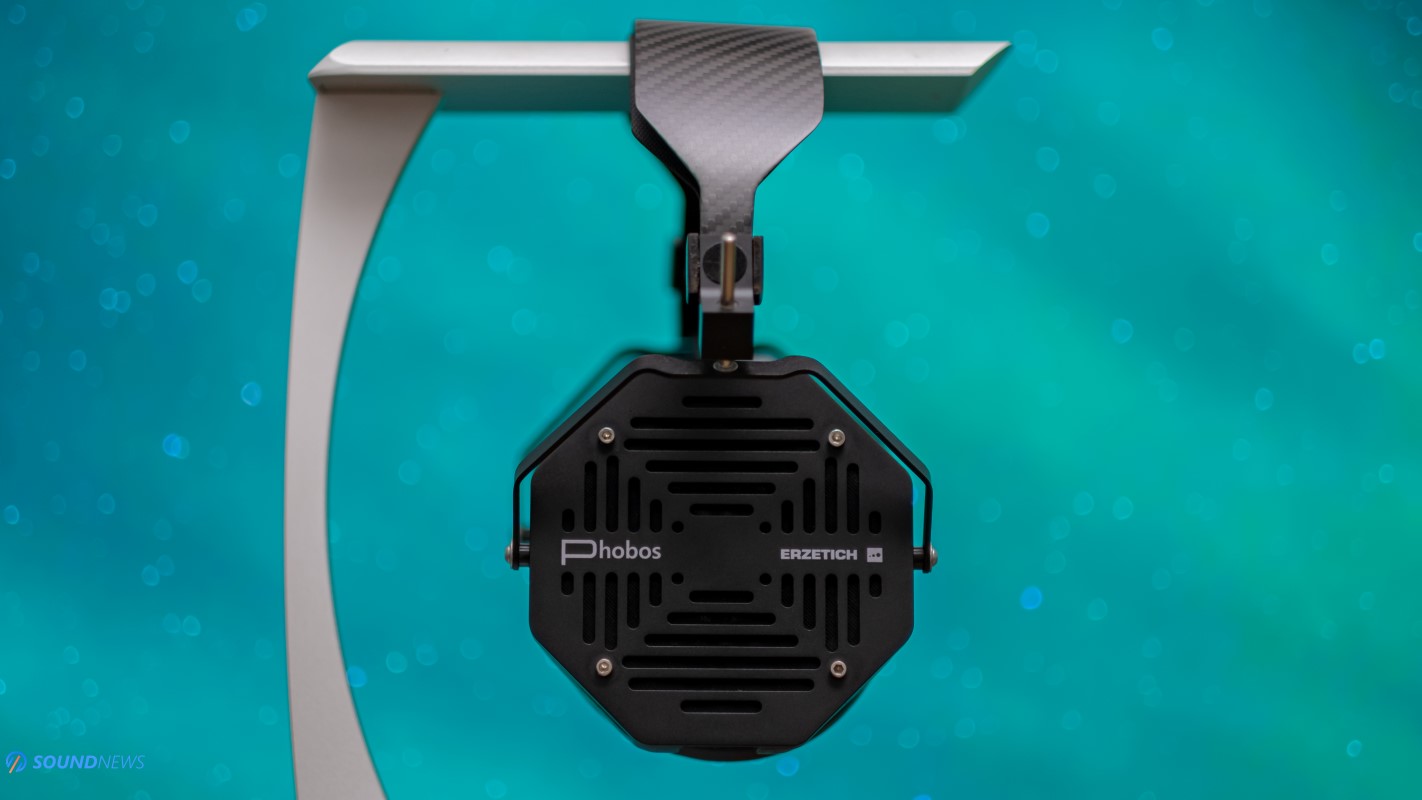Erzetich Phobos V2021 Review – Goliath 2.0
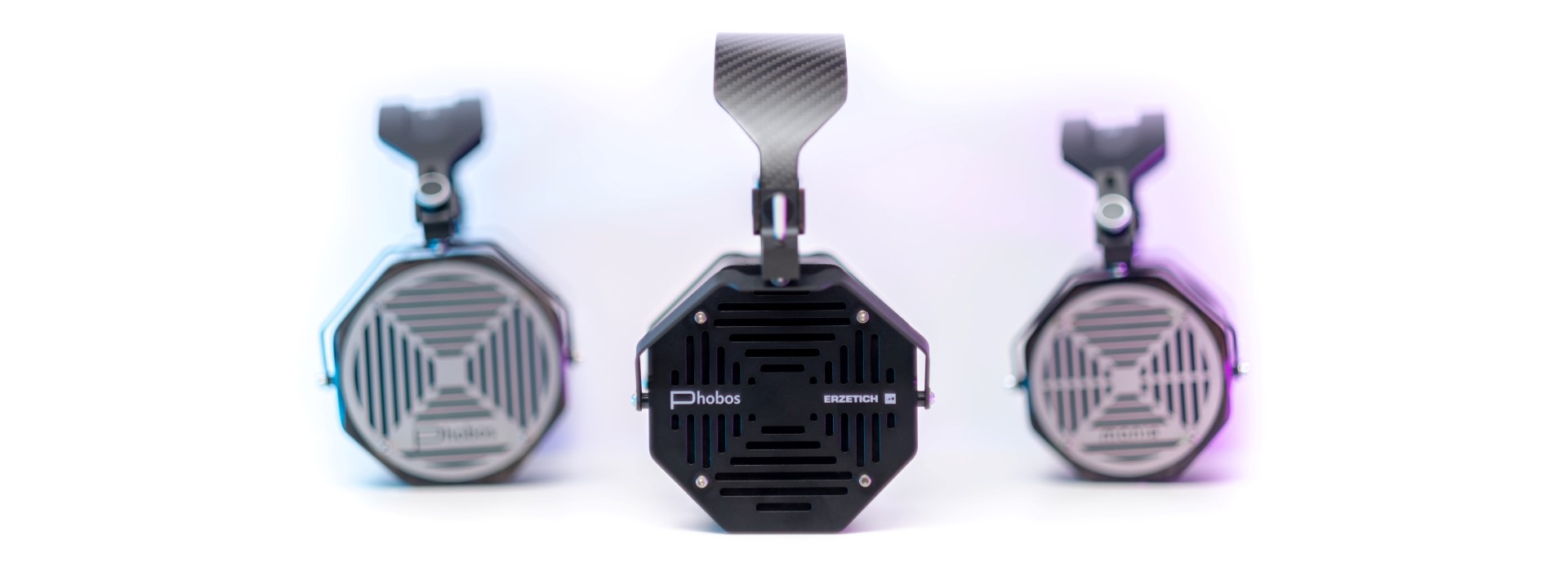
My Video Review:
Oh, my goodness, what a busy year! It seems that headphone tinkerers around the globe went berserk in 2021 after a dormant 2020. Hifiman went all-in with stealth magnets on their Arya and Deva Pro, Sendy Audio released their golden child – the Peacock, Dan Clark Audio wowed the world with Metamaterial Tuning System in their flagship Stealth headphone, Kennerton released a fearsome-looking Rognir closed-back that sounds more like an open-back unit and of course, Audeze put a crown on their newest and greatest LCD-5. There was another surprise from a boutique headphone maker from Slovenia, that re-designed from the ground up their entire desktop headphone line. I’m about Erzetich Audio that face-lifted their Mania and Phobos with fresh looks, exchanging their unpolished appearance with CNC-ed aluminum cup covers, with a brand-new height adjustment clip, with a carbon fiber headband that lowered their weight by a little and most importantly they better decoupled their drivers, lowering some distortion, while boosting transparency and detail retrieval. Instead of going with brand new names, a V2021 suffix was added to avoid confusion. The best part yet? They cost exactly the same as their 2018 version
Their original-gangster Phobos can be seen in a lot of headphone related reviews around here, because those are some of the nicest sounding headphones I’ve tested around here and I cannot wait to experience the improvements of the newest model. As you can expect, Phobos V2021 is not your usual off-the-shelf headphone, this is a hand-crafted model that ditched dynamic-drivers in favor of some over-sized planar-magnetic ones. If you are wondering from where they’ve got their name, Phobos was the personification of fear and panic in Greek mythology. Phobos was the son of Ares and Aphrodite, and the twin brother of Deimos (Erzetich’s best solid-state headphone amplifier to date). While putting them near some other top-of-the-line headphones, suddenly I understood why Phobos is such a fitting name. It’s one of the biggest units that I’ve played with and that makes them stand out from the rest.
I’ve already tested all their former headphones, from their portable open-back €599 Thalia, to their desktop dynamic-driver €1199 Mania and then their God-tier €1999 Phobos, but I’m curious and genuinely excited to know if their aesthetic retouch made an audible impact on the sound quality. I’m a little sad that not a lot of people know about this boutique headphone brand, but I assure you…they deserve your fullest attention and if you have a chance for a listening session, please give them a try. You’ll thank me later. If you’re interested in getting the Phobos V2021 or anything else made by Erzetich…I might have a little surprise for your at the end of this review, so keep going until the end.
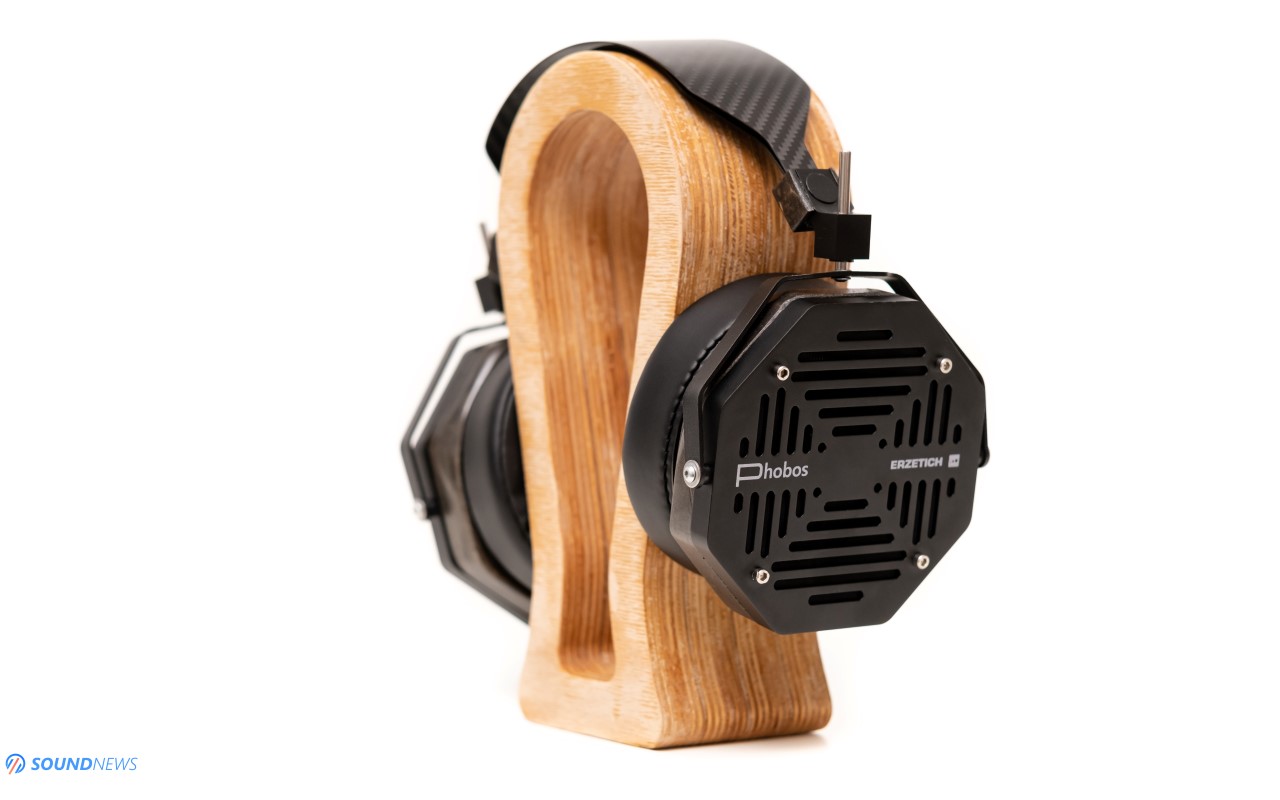
Unboxing
Erzetich Audio prepared a similar unboxing experience to their Mania and Phobos headphones that I’ve tested a year prior and that’s a good thing, as they say: if it ain’t broke, don’t fix it. Everything seems carefully packaged, double boxed is the usual affair, wrapping all that with environmentally friendly materials, free of plastics or other nasty things. The product box is filled with a substantial amount of foam that will guard the mighty Phobos from the outside world. Besides that, you’ll find an oversized velour pouch, a certificate of authenticity, an owner’s manual and a 2-meter-long detachable cable. It’s the same good-old cable found in their OG Mania and Phobos, that seems well-made, thick and quite stiff, it uses mini-XLR connectors on the headphones end and it’s terminated with a 6.35 mm (1/4”) headphone jack.
Their cables are hand-made, they use high-purity copper conductors, I see a metallic splitter with a carbon-like look, some sturdy gold-plated jacks, all wrapped in an RF shielded jacket. There are two things I dislike about this cable: 1) There are some microphonics when it’s rubbing against my clothing. 2) The RF shielded jacket is helping you against RF interference, but it makes it considerably stiffer and less flexible. Forget about using it with portable devices, it’s inconvenient and a little unpractical if you ask me. If it bothers you too, you can always exchange it with a third-party one or you can use your standard Audeze, Kennerton or ZMF cables.
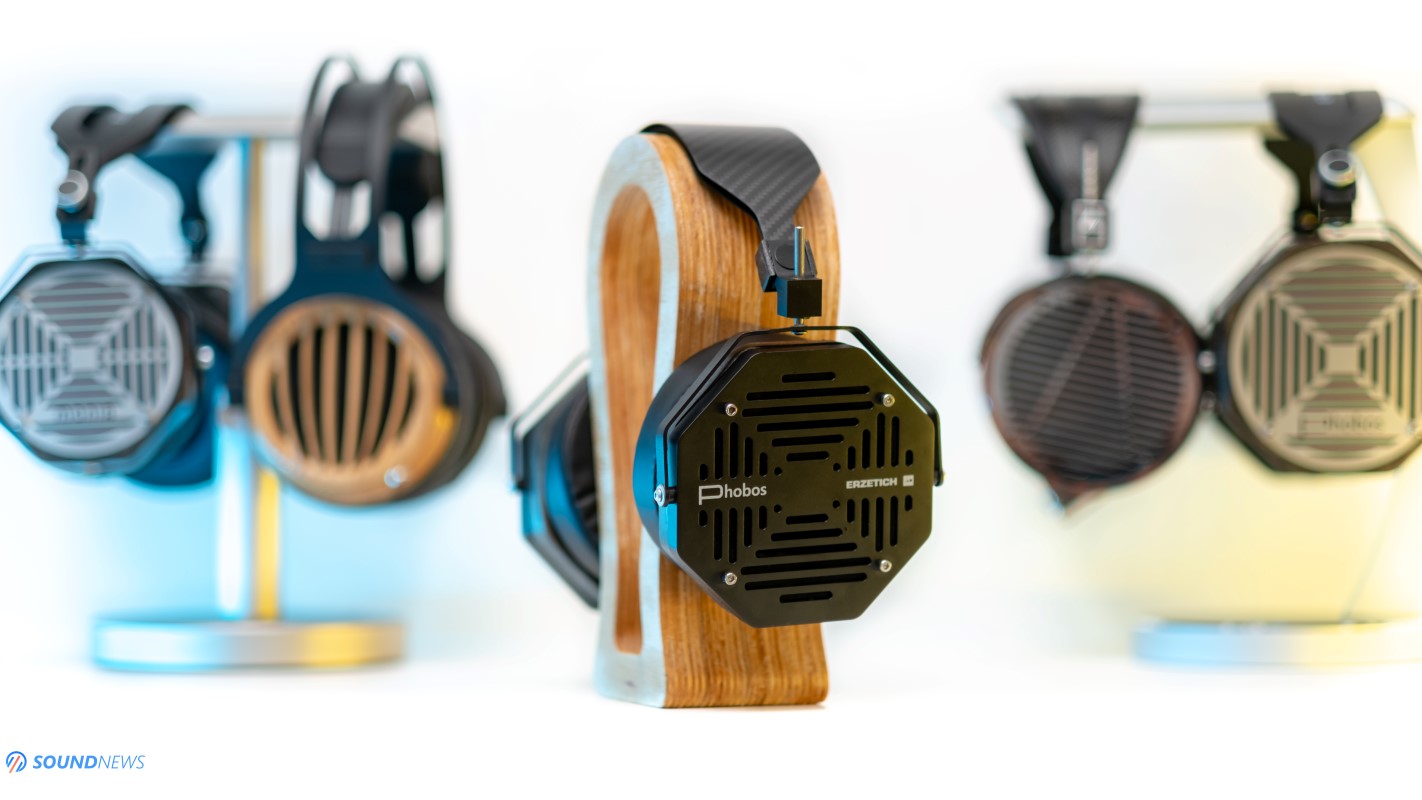
Build Quality & Looks
As their predecessor, the newest Phobos is a monster of headphone, dwarfing any other units from my personal collection. If you think Audeze LCD-4 and Hifiman HE1000SE are big, bold and scary looking, wait until Phobos hops on the same table. With V2021 version, Erzetich redesigned their earcups from the ground up, adding a CNC milled aluminum cover, crafting a brand-new height adjustment clip and a carbon fiber headband that adds style and authenticity to a familiar face. Underneath their metallic cup covers, you’ll find aged linden wood cups that are manually carved in a striking octagonal shape. Their cups have colossal proportions and that’s what I like the most about them, with a diagonal of 11.3 cm, these are simply the largest ear-cups that passed through these hands.
Their earpads are detachable and are made out of leather free materials (TPU leather). They are wrapping my ears snugly and if you have a bigger melon like mine, you shouldn’t worry about the comfort levels, as they provide the right amount of side pressure and the right earpad opening to be worn for a couple of hours.
Its entire frame is made out of reinforced steel that is powder coated with a matte black paint and it is reinforced only by nuts and bolts. At this point, they aren’t offering replacement parts, but if anything goes sideways, please shoot them an email, Blaz will take care of you headphone and put in back on your head in no time. Their height adjustment mechanism is simple and practical and by default it stays in the lowest position. Gently pull the pins between the headband and earcups to a desired position, it’s simple as that.
Like the rest of their headphones, the newest Phobos has a 100% symmetrical design, so any ear-cup can be your right or your left cup, therefore it doesn’t matter which way you put them on your head. You don’t have channel markings on the headphone, only on the cable itself. A red ribbon right below the mini-XLR connector will highlight the right channel for you. Apart from this, the newest version looks more or less the same and that’s a good thing in my book.
Having huge drivers, plenty of magnets, massive earcups and a steel structure made a big impact on their weight. This is a heavy-duty headphone, at around 680 grams (1.5 lbs) it is on a heavier side of thing, but thanks to fluffy earpads and to an even distribution of weight, I can wear them for prolonged periods of time, without feeling discomfort or pain around my ears.
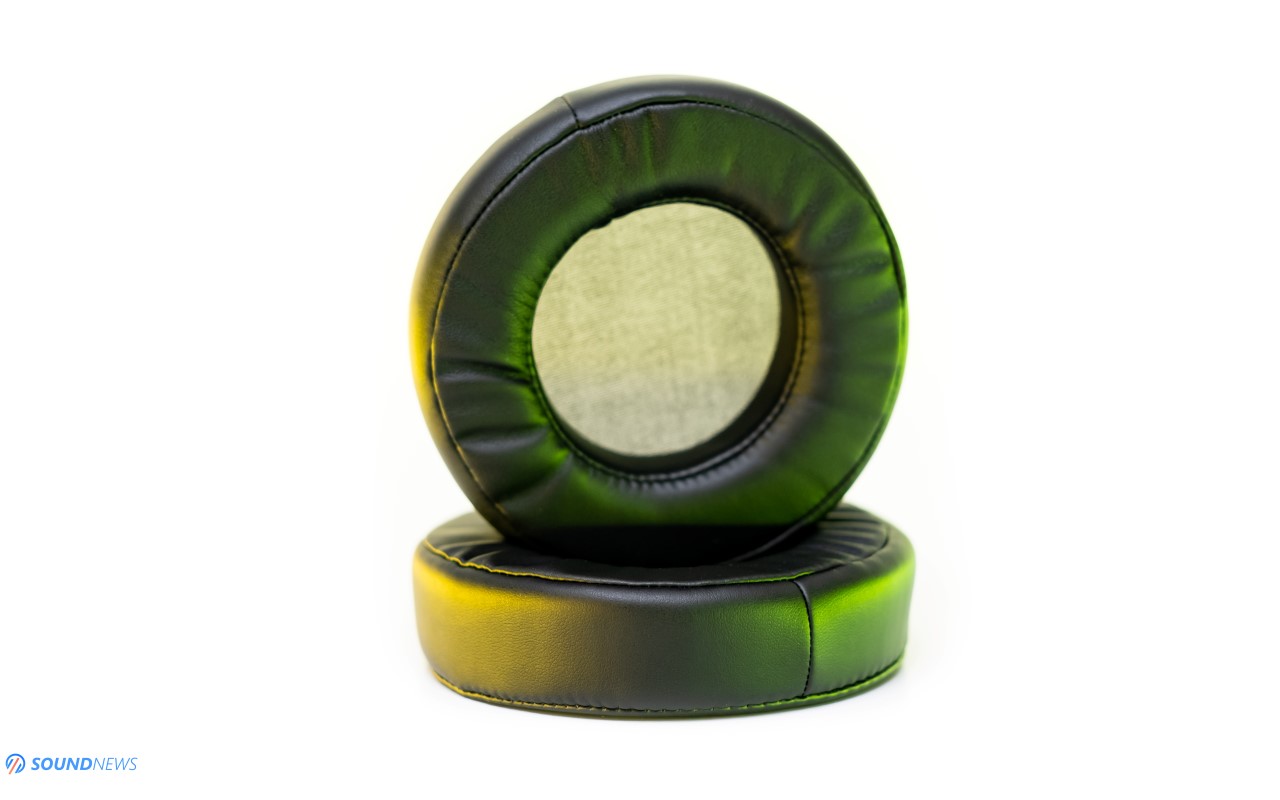
Comfort Level
The ear-pads are deep, soft and are padded with some kind of memory foam. I find them gentle on the cheeks and soft enough to be used in long listening sessions. There is a small gap in between them and the driver assembly (exactly how some other brands are doing), meaning that there is no pressure building up and you should forget about sweaty ears in the summer time. Their pads resemble the stock ones of several Kennerton headphones. They fit around my head snugly and provide enough padding, putting little to no pressure around my ears. In their stock configuration, there was a higher side pressure, but once I’ve adjusted them to my head size, everything went back to normal. Obviously, Phobos doesn’t offer Sennheiser HD800 or Hifiman Arya comfort levels, but it isn’t that far off, so no complaints from my part.
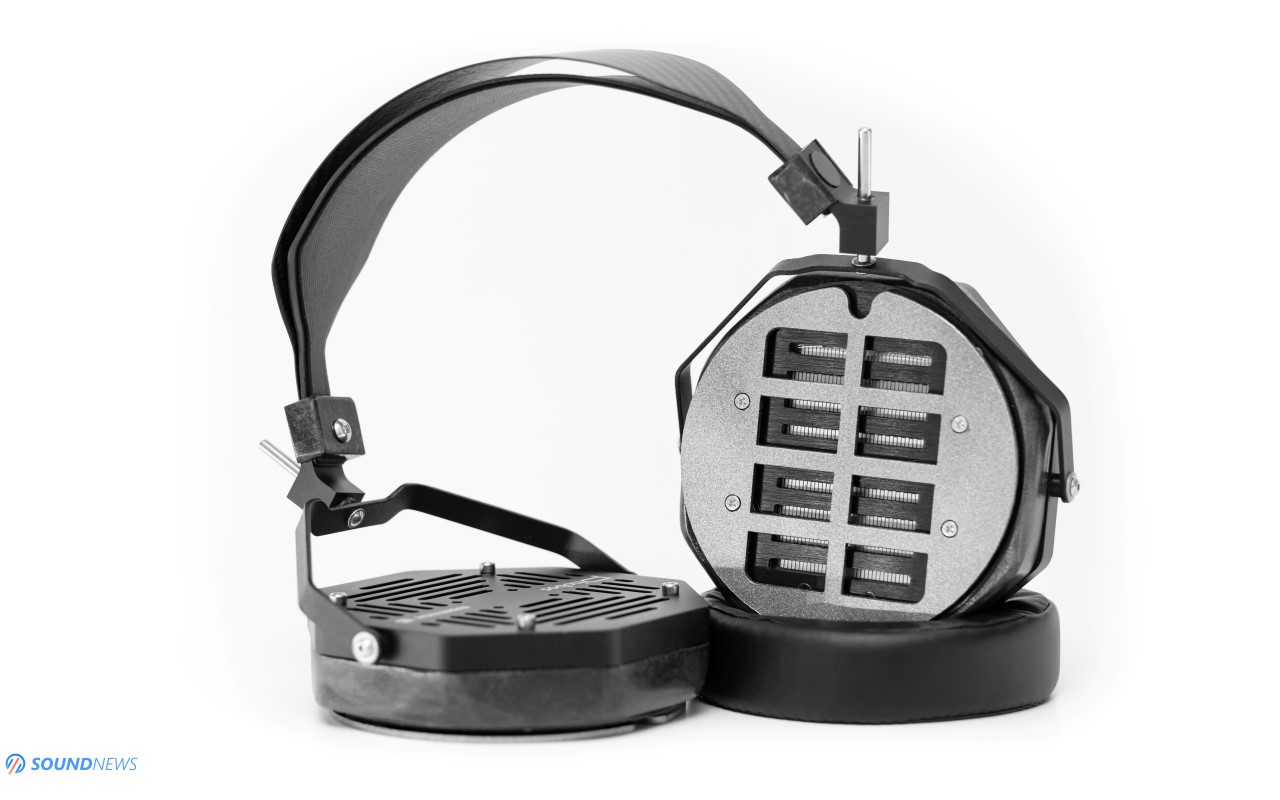
Tech Inside them
First of all, Phobos is an open-back headphone that uses some of the biggest planar-magnetic drivers in existence. Erzetich doesn’t specify a lot about their drivers, mentioning only their impedance of 45 Ohms and that’s where all the specs are seeing a full stop. After opening them up (which you shouldn’t do) I’ve measured the driver assembly at 105 cm in diagonal, which is huge by my standards. You can spot multiple openings on their cups, these will be leaking a lot of sounds outside, sounding like a proper open-back headphone from any point of view.
No sensitivity numbers were given, but since I can drive them decently with a laptop, they will probably work with majority of mobile sources, but obviously some nicer quality ones like a dedicated DAP or an external dongle will sound considerably better and you can add a dedicated headphone amplifier to the chain later on, improving their performance to the next level. Armed with a MiniDSP EARS system, I could actually compare its sensitivity with some of my other headphones. As I was expecting, it needs exactly the same power to the OG Phobos, it is only by 4dB less sensitive to a Kennerton Wodan, meaning that their sensitivity sits at around ~ 99-100 dB per a single mW of power. I don’t see it as a power-hungry headphone, but it will definitely sound better out of dedicated audio sources and amplifiers.
Their high-ish sensitivity seems to come from big and powerful magnets and from a low-mass diaphragm, making them work nicely even with portable devices. Alright folks, it is time to have a proper listen to the mighty Phobos V2021.
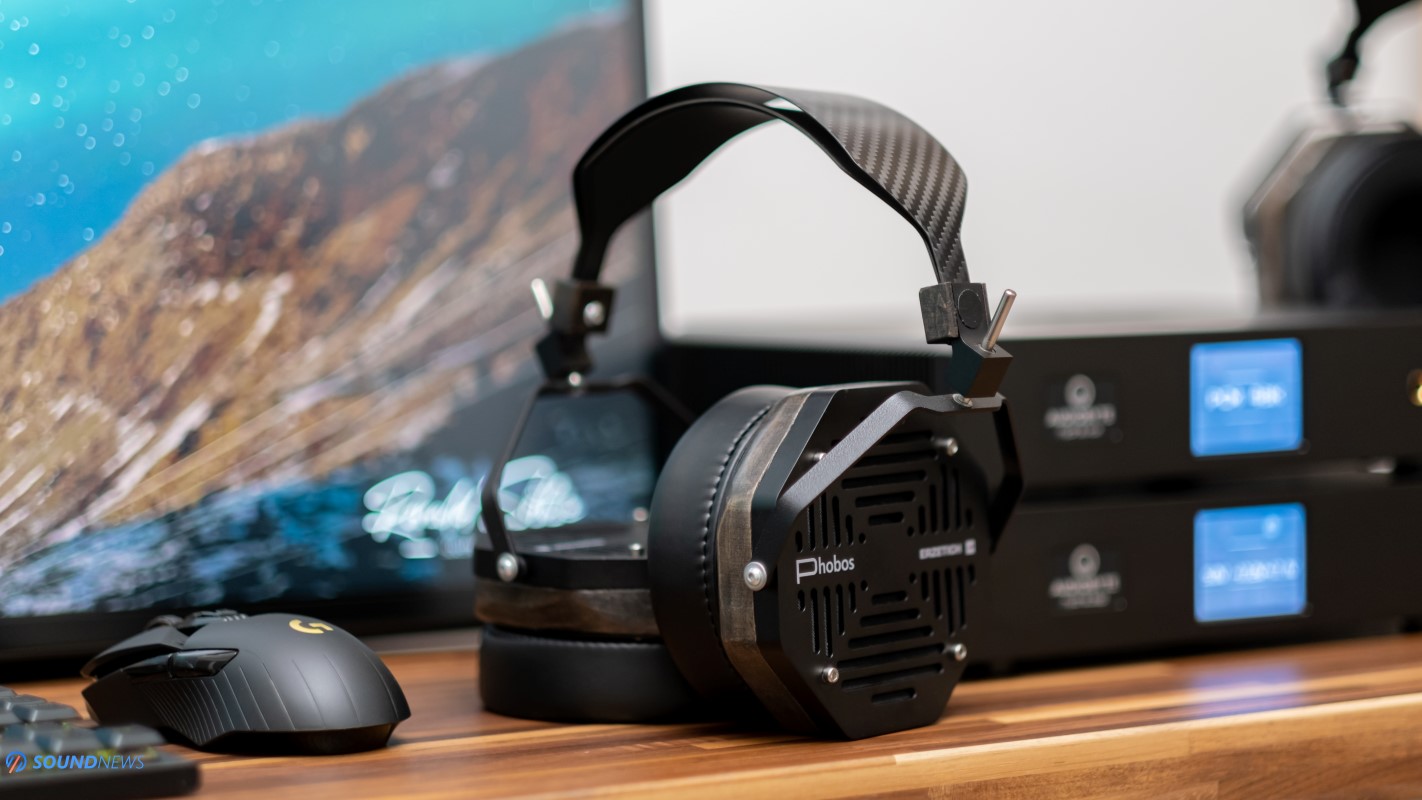
Sound Performance
I. Preliminary Sound Impressions
Phobos V2021 are staying at my side for several months now, they have hundreds of hours of head-time and I believe that I’ve formed a very solid opinion about them. It isn’t a novelty that minor changes in cup and baffle design can have a big and substantial impact on the final outcome – on the sound quality itself. For the record, these are using exactly the same drivers of the older Phobos, they have the same impedance and sensitivity and yet, they sound quite different to old Phobos. This one is purer and smoother sounding, there is less ringing and distortion up top, while toning down a minor brightness of its predecessor. It seems that Erzetich solved the biggest shortcomings of its predecessor, completely discarding an unnatural ringing that was happening in the treble when I going past 90 dB volume wise. If you don’t go very loud on your amplifiers, the old Phobos still sounds incredibly dynamic and alive.
With the newest creation, distortions are going out of the picture even at higher volumes, improving driver control and their timing, while sharpening the leading edges and adding an additional layer of information. From a solid 8 out of 10, the newest Phobos jumps higher to a 9+ out of 10, improving their tonality, making them more technical, more cohesive and more natural sounding, while costing exactly as much.
Apart from that, the newest Phobos are mighty fine sounding, definitely flagship material. I find them extremely resolving, so much so that they easily outperformed the likes of Meze Empyrean, Audeze LCD-2 and LCD-3, approaching dangerously close to the LCD-4. I find them by a hair more technical to the Kennerton Wodan and more or less on the same level with the Hifiman Arya Stealth edition.
The very first things that stepped into the light was their faintly elevated mid-bass and midrange performance. Anything that has to do with instrumental music, with big orchestras, with classical, jazz, blues, rock and everything that highlighted the vocals sounded close to the real thing, adding a lot of substance and meaning to those genres. More than anything, Phobos are sounding exactly as their name suggests, these are scary fast and impactful, sounding bigger to most planar-magnetics when it comes to depth and stage size. Armed with some ginormous drivers, Phobos sounded bigger, more fleshed out, deeper and more expansive to the likes of Audeze LCD-4 and even to the Hifiman Susvara while being driven by two power amplifiers. I believe their technicalities and soundstaging abilities are up there with some of the nicest headphones. I can only presume that a slight gap in between their cups and earpads somehow boosted their scale, added some air in between the notes, making them breathe, while increasing the left to right soundstage.
Due to a slight emphasis in the mid-bass and midrange regions and to a gentle roll-off in the treble, they sound powerful, rich and full-bodied, they carry a denser type of sound. I remember exchanging some emails with their creators before V2021 came into existence and I expressed my feelings about the treble ringing on the older Phobos that needs to be dealt with and this is exactly what they’ve done. I can now listen to all my rock and metal tunes without feeling discomfort and without lowering my volume below 80 dB. It is a little unusual that the newest Phobos uses a lot more metallic parts to their predecessor and yet they sound more natural and life-like to the good-old wooden Phobos…this looks like headphone engineering at its best.

II. Power Requirements & Amp pairings
Contrary to popular beliefs, even a scary looking headphone like Phobos can sound decent enough out of regular headphone jacks. With a sensitivity of ~99 – 100 dB per a single milliwatt of power, these will sound loud even out of a laptop or tablet, but you should forget about dynamics, sustain in the bass and control with such low-end sources. As of right now, from a bigger headphone collection, Erzetich Phobos, Kennerton Wodan and GoldPlanar GL2000 (double-sided magnet version) are among the easiest to drive planars that I know of. Their low impedance of 45 Ohms is giving a big helping hand, their thin diaphragm and powerful magnets are also leaving a huge mark on their sensitivity. I had a business trip to Italy and back somewhere in August and you can guess which headphone went with me and back home, sounding sublime out of portable devices like Shanling M8 and FiiO M15.
I have several portable and desktop headphone amplifiers at my disposal and luckily, Phobos worked beautifully with them all, improving slightly with higher-end desktop units. No matter what headphone jack was driving them, their natural and full-bodied tonality always carried over, always pressing the gas pedal when it comes to dynamics and fun factor. My smartphone and a Surface 7 Pro drove them decently enough at close to maximum level, but I’m advising getting at least a portable dongle like Shanling UA2, FiiO KA3, iBasso DC04, Hilidac Beam 2S or better yet, you can go with a nicer DAC/Amp or with a smart portable music player that can offer you streaming capabilities.
Putting them on six desktop headphone amplifiers, ranging from super linear and honest sounding THX-AAA and NFCA amplifiers, to smoother sounding transistor-based amplifiers and then on the warmest Class-A amplifiers, it seems that every single one easily drove them to their best. I’ve had all the signs of a well-driven headphone, dynamics were up and down like crazy, bass notes were hitting me like sitting in between the hammer and the anvil. They sounded effortless even with crowded music and I’ve never experienced them closed-in or claustrophobic even with bad mastered music. The nicest all-in-one unit that put plenty of smiles on my face was Audiobyte Hydravox, that injected dopamine, working like a charm with them.
Unsurprisingly, even THX-AAA and FNCA designs, worked great with them, as Phobos doesn’t need a lot of warmth and smoothness coming out from my electronics. On my Big Rig (Matrix Audio Element X + Benchmark HPA4), Phobos put on a plate everything that they have to offer. If you are a solid-state guy as myself, go with transistor based (MOSFET, JFET or better yet – Bipolar) Class-A amplifiers that worked The Best with them and if you are a tube guy, hybrid amplifiers (SS input, tube output) worked nicer with them, fully preserving their speed, slam and ultimate transparency. If you already have a warmer sounding source (R2R, NOS, FPGA, Tube output stage, turntable) then you can use any amplifiers you please, including ultra-linear ones.
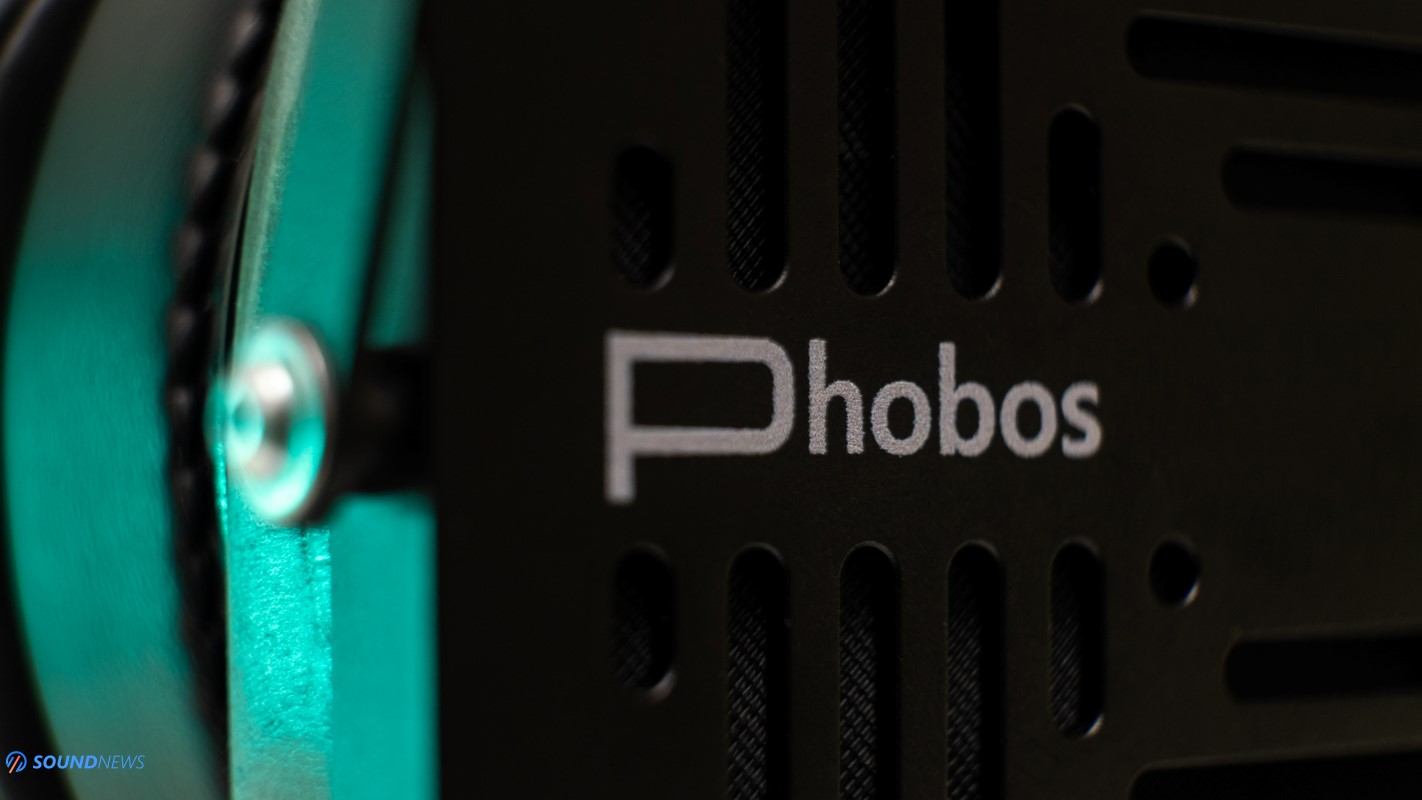
III. Transient Response
Start repeating these words together with me: easy to drive, oversized drivers, colossal magnets that are working in a push-pull configuration and tell me what are you thinking of? Besides being technical, Phobos wants to be remembered as a fun-sounding headphone, this is not your typical dead-flat and linear sounding planar headphone as Hifiman Susvara. These are adding lots of fun and color on their own, putting more meat on the bone and a lot of substance, up until treble is being reached. When Igorrr and Gojira appeared on my playlist, it was clear as the blue sky that I’m dealing with a fast-moving diaphragm, firing canon-like bass notes with modern and impactful music.
When Flux Labs Acoustic Volot came to play with them, it felt like releasing a beast. The whole soundstage grew to scary-big proportions and all the bass notes started appearing in the most unusual places. The last thing I am thinking of when I’m listening to my Blues collection is bass, but still, here it is, looking and smiling at me. What I want to convey it really simple: put them of a transistor-based amplifier and watch those drivers fly, slam and pound your eardrums with an unstoppable force. There is just one thing I dislike with the newest Phobos…the sub-bass region is rolled of by a little, meaning that most of the impact and slam will be felt starting with 50 Hz and upwards and everything happening below that point will sound less focused and muted in a way.
From my personal collection, Phobos is slightly punchier sounding to the Kennerton Wodan, considerably more fun to the Hifiman Arya Stealth and Sendy Peacock. The only headphones that are outperforming them on the fun factor alone are the Audeze LCD-4, Hifiman HE1000SE and Susvara…which is sincerely, an impressive feat coming from the house of Erzetich. There is no point of going through a series of tracks just to arrive at the same conclusion, that Phobos V2021 are scary, merciless, visceral and impactful with the right music. Blaz, you did a great job in here. Chapeau Bas!
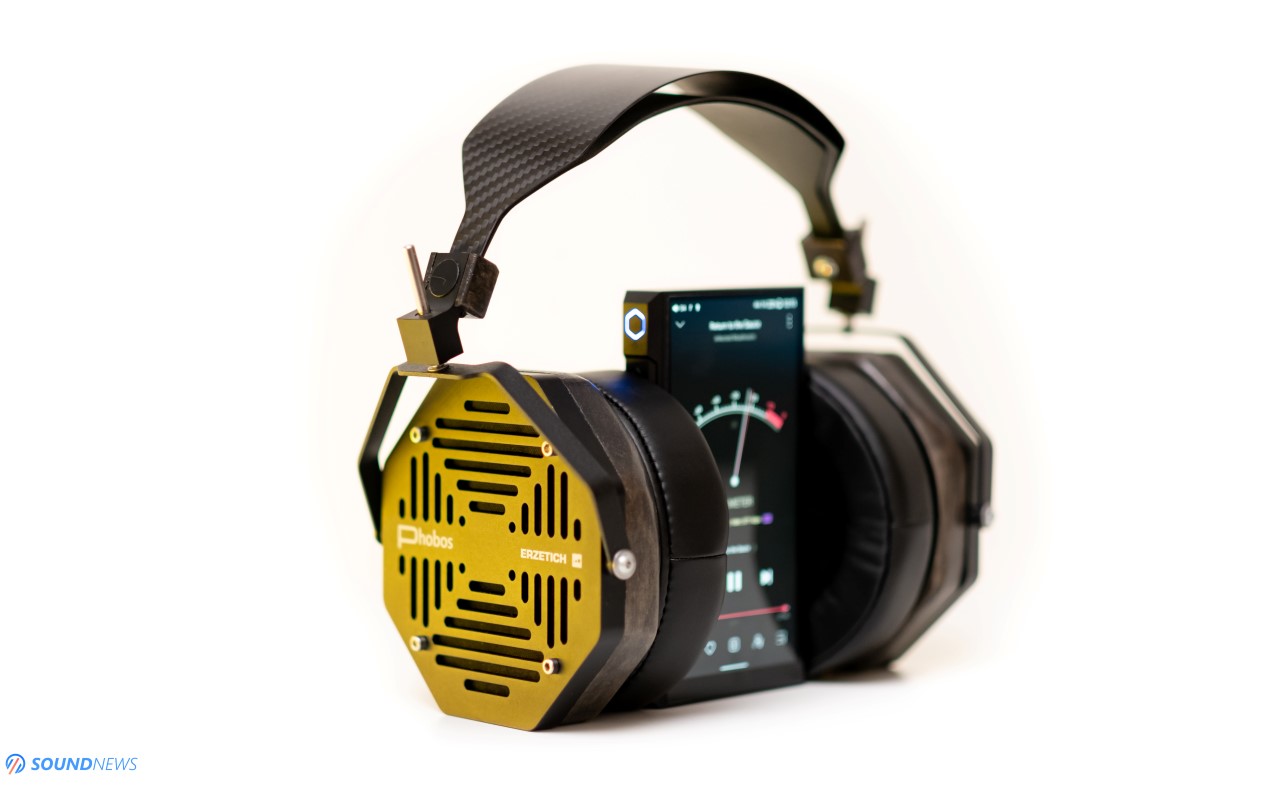
IV. Soundstage
Father Odin, hold me still, as some shilling moments will follow shortly. While I really enjoy their fun and impactful nature, always trying to lift my mood with their natural tonality, they impressed me more with their airy presentation. I am crazy about transients and those are very important to me, but I cannot overlook their massive left to right soundstage that is stealing a lot of attention. This is a big, truly enveloping sound that feels decompressed and airy even with bad-mastered music. In all honesty, bad mastered music is like 90% of my audiophile diet, I never wanted nor chased that, but nothing I can do about my rock and blues collection. Their massive earcups are sending huge quantities of air towards my eardrums, always delivering a massive wall of sound that comes in waves one after the other. When I’m returning back home with some IEMs inserted deep into my ears and then swapping them with something like Phobos, that moment always WOWs me. Everything appears several times bigger, like some near-field monitors are playing in front of me and not some ordinary headphones with drivers sitting centimeters away from my eardrums. If you want to be surrounded by music coming from everywhere, even from top of your head and behind your back, I don’t believe there is a more interesting planar headphone. Transient response might be their true calling, I mean fear is still their first name, right? But scale, stage size and an amazing depth is their nickname. I’m pretty sure about this.
Half of my time I am listening to music in my office swapping between a Flux Labs Volot and Benchmark HPA4, not because I want to, but mostly because HPA4 can disappear from my acoustic chain, so I could listen to the voice of my DAC and to the character of the headphone. With that setup, I can see through any headphone and feel their tuning much better. HPA4 has just one drawback – it’s not that massive when it comes to soundstage and still, with this exact setup, Phobos were bigger sounding to my other headphone put on Class-A amplifier. Another job well done in here.
This is not a natural soundstage…this is a biggity big one, the one that makes you count instruments playing in a track and the bass layers passing through near you. Of course, it’s not overly large to a point of becoming fake as it happens with Sennheiser HD800/800S, but it is not that far off if being completely honest with you. Depth and imaging are equally good, I could focus on anything even with less than perfect recordings, I could follow a single instrument and trace it for the rest of the track without having a drink before or closing my eyes. Seriously now, if this is how Phobos sounds, I wonder how Apollo or Terpsichore would sound, if Erzetich would ever craft such models. (Please do!)
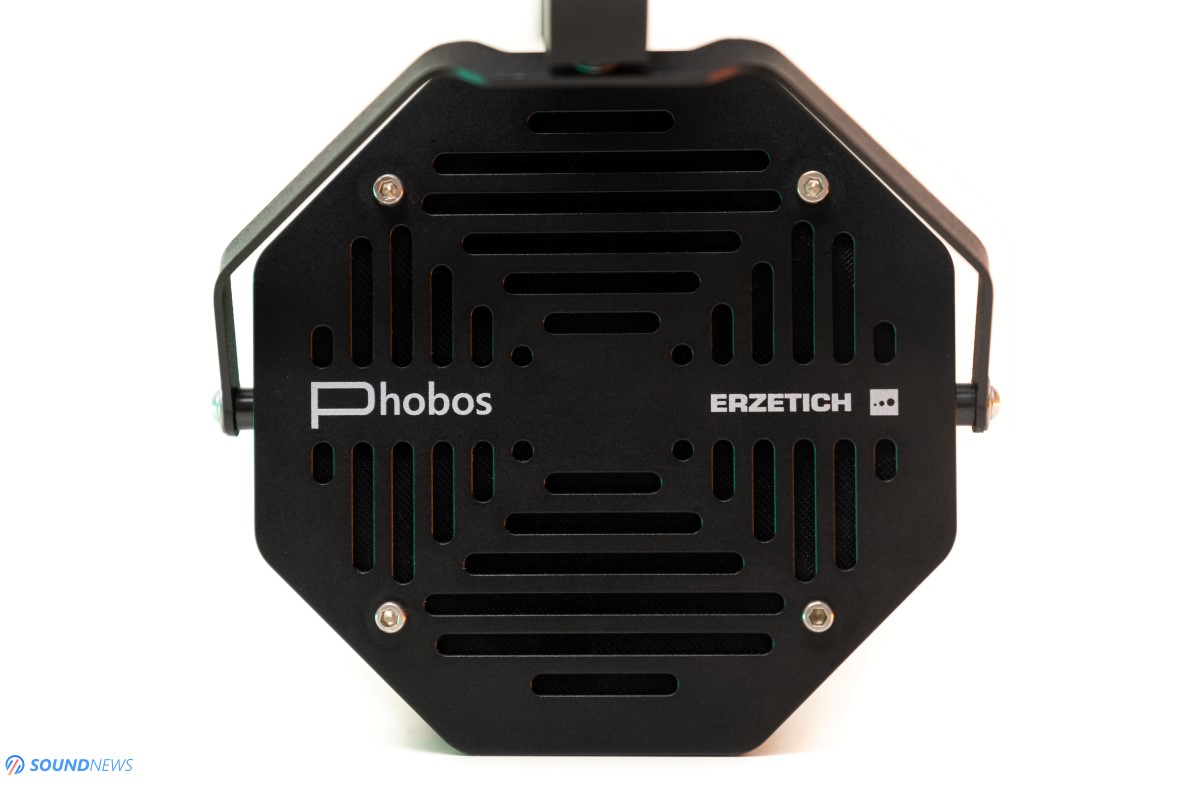
V. Detail Retrieval
Erzetich himself describes them as “The design and technology together enable a detailed, firm and dynamic sound: picking up the details in the music and allowing you to bask in the rich details of performances that you love” and a little later “Compared to Phobos V2018 the sound is now more controlled, firm and detailed.”
The moment I am going past 90 dB volume wise, is the moment of truth for many headphones. I am measuring my headphones at an SPL of ~85 dB, because usually past that point a lot of headphones start breaking up when it comes to distortion…but not on Phobos V2021 watch. Their precursors were already quite impressive in this department, but not when I was going much louder. Erzetich made their structure more solid and stiffer this time around, so it would not dance together with their drivers. Distortion went lower, transparency went higher and suddenly additional micro-details paid me a visit. If OG Phobos was already cruel and merciless when it comes to mastering errors and all the stuff happening behind our music, then Phobos V2021 is even more impressive. There is a substantial difference between their OG Phobos and V2021 edition when it comes to cleanness and only after comparing them closely for a few days, their older brother can appear as slightly muddier and unrefined sounding. I’m not writing it as a mindless zombie because it looks cool on paper, but because I find the V2021 more detailed to the Kennerton Wodan and Sendy Audio Peacock and it’s more or less as clean as the Hifiman Arya Stealth. This is a huge achievement for a headphone maker that can be described as a one-man band.
Small nuances? Easily, can’t hide them. Mastering errors? Too many showed up uninvited in my tracks. Chit-chat in the auditorium on live recordings? Please make them stop! You can easily compare DACs and amplifiers with such an honest sounding headphone and I didn’t need reference recordings to feel a higher transparency and that a veil is being lifted from my music.
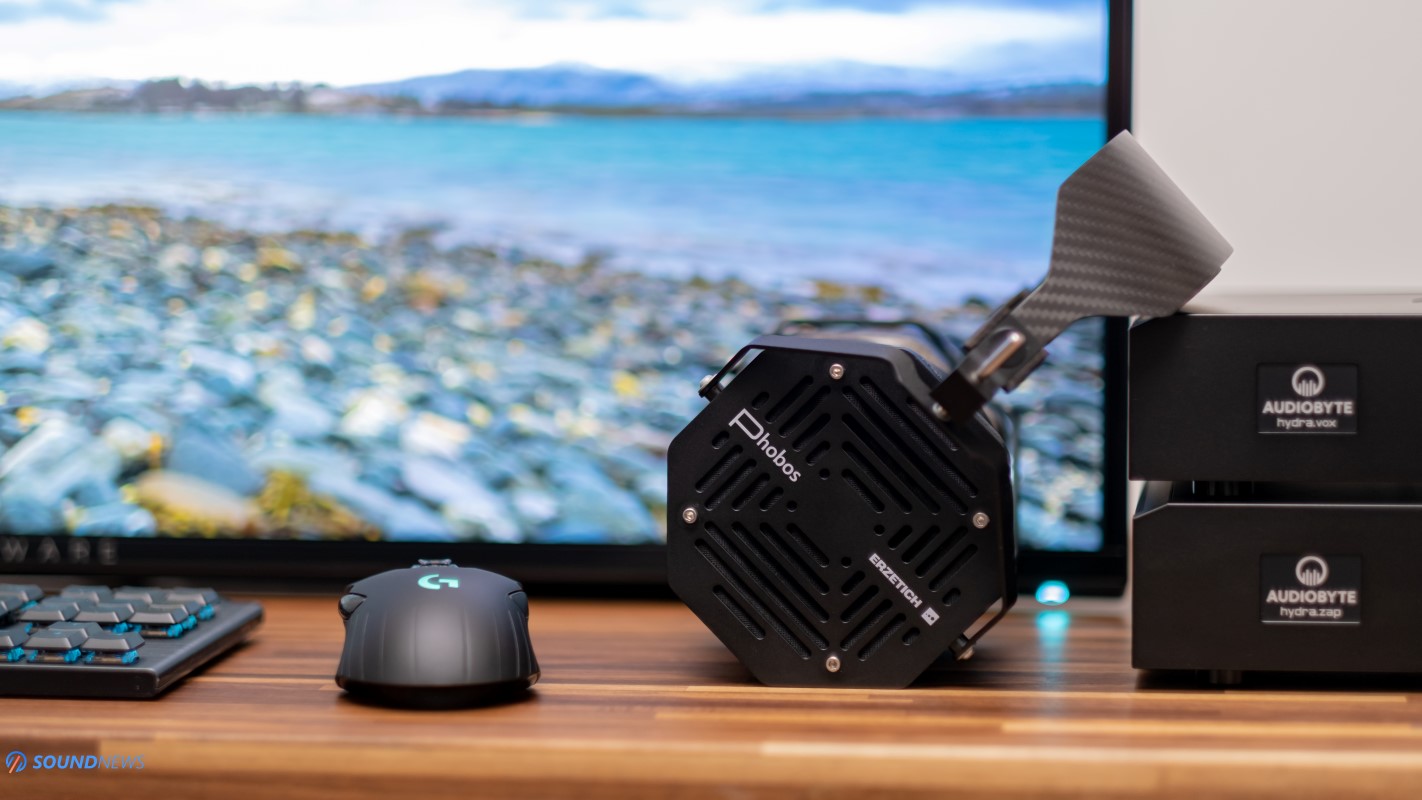
Frequency Response
VI. Bass
There are some good things and fewer good things to say about the Phobos in here. First of all, the sub-bass isn’t that impressive up until 50 Hz is being reached. You can improve it with full leather pads like Kennerton ECL-02, but you’ll lose some definition and crispness. There is quite a substantial difference between sub and mid-bass, mostly because you’ll hear the mid-bass a lot more often, as it is elevated by a few dB and that’s what makes them fun and engaging in the first place. If you can live with that, then Phobos are becoming quite special. Apart from a substantial difference between these two regions, you’ll find an agile type of bass that just keeps on going like a hyper car. Phobos will immediately increase their pace once fast tunes are making an appearance on my playlist. I tried chocking them down with fast electronica beats, but I couldn’t do that, as they were keeping up, never messing with the cleanness and the transient response. I’m talking about a clean, defined, impactful and hard-hitting bass that doesn’t linger for a microsecond longer and that wants to impress you right away. This is a high-quality type of bass that hits you like a wall of sound. Sure, it’s elevated by a few dB once 50 Hz are being reached, but who cares about linearity, when all that becomes engaging and I can’t stop from head-banging like a madman.
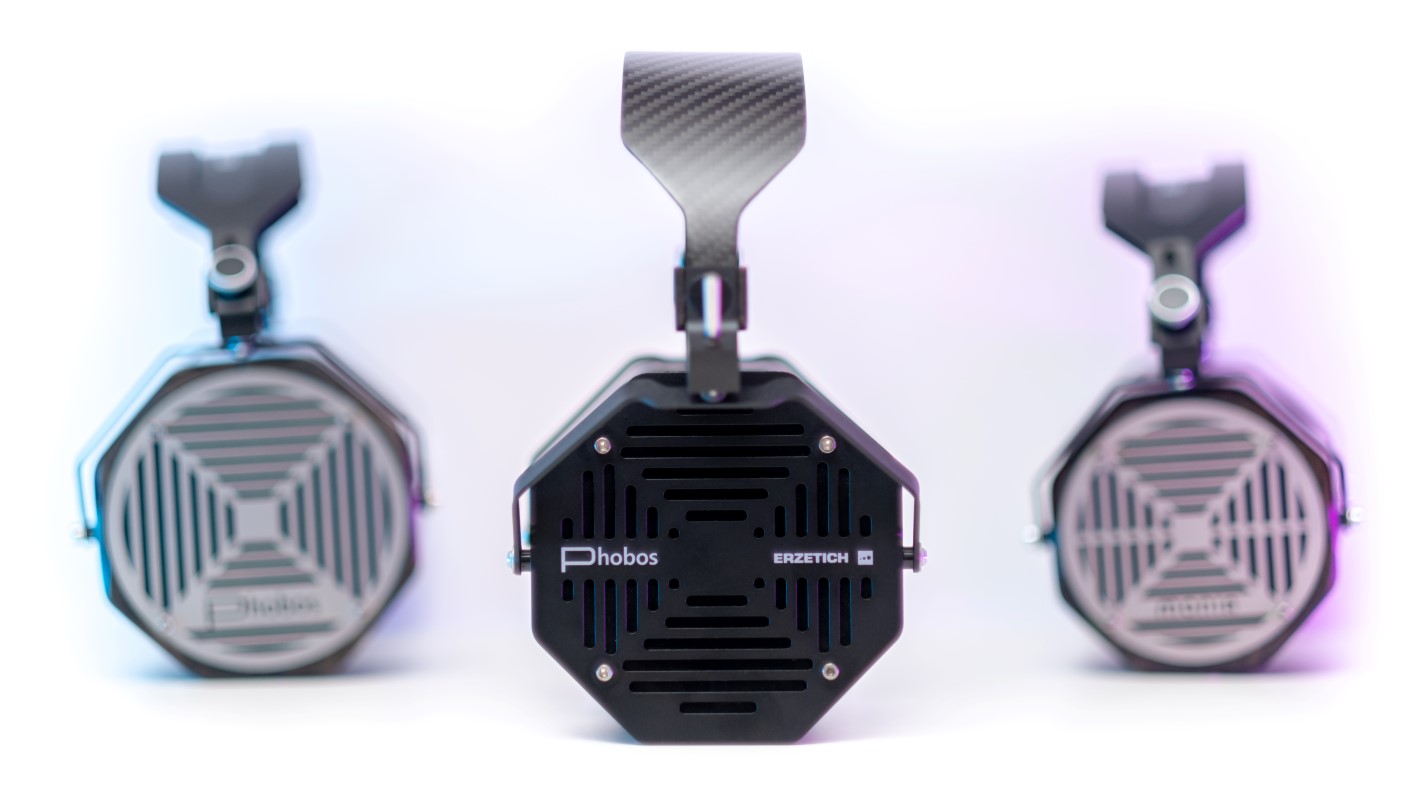
VII. Midrange
When we’re talking about planar headphones of colossal proportions, we are certainly talking about amazing bass and midrange definition and that is certainly the case in here. Midrange is the only region that feels straight as a line, it’s fully preserved, never going up or down, but always being present in my tunes in right doses. Phobos starts strong in the midrange and can sometimes remind about mid-forward headphones as Meze Empyrean or Audeze LCD-4 to some degree. There is plenty of warmth, there is some smoothness but not a lot of it, there is presence and weight in there too. You’ll certainly hear and feel the added weight of piano, double-bass and organ notes, murmuring and slowly moving around your head. Vocal performance is just spot on, there is quite a big difference between female and male voices, fully covering their pitch, as again, the midrange area is fully preserved. This is what I’m calling a natural and life-like type of midrange, that never goes towards the overly creamy and heavyweight side, it comes in right doses and never overdoes it. Their midrange performance is simply immaculate, it’s their standout and if you are into a lot of instrumental music, then you’ll be pleasantly surprised by their performance.
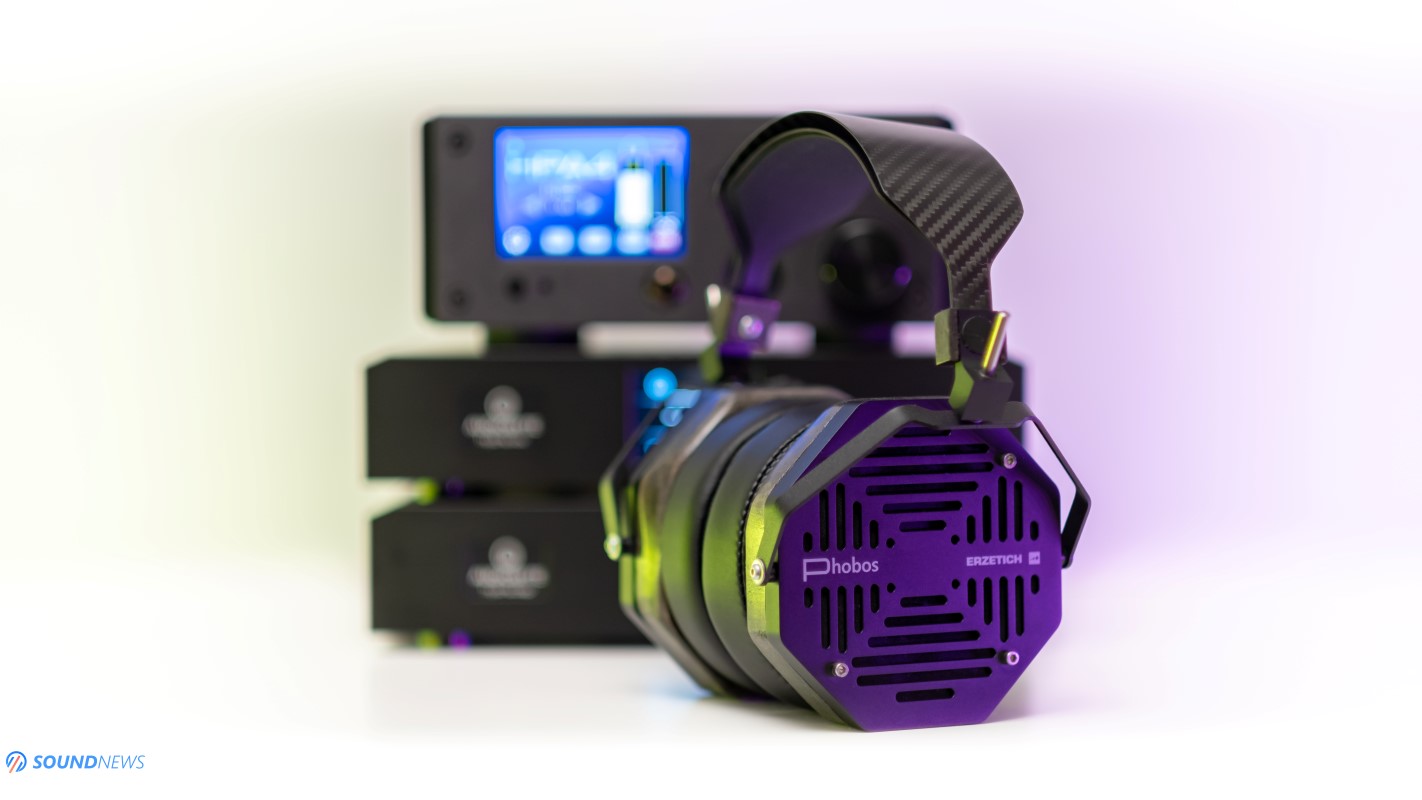
VIII. Treble
As usual, treble performance is a roller coaster with this model and with many other headphones. In some ways it is similar to that of the older Phobos and in many other ways it is completely different and let me explain you why. First of all, the newest Phobos are covering the treble area in full and there is plenty of information even past top octave. There are several dips around the most sensitive area of our hearing, but there aren’t spikes and rises that could pose a problem in long listening sessions. Newest Phobos adds more nuances in the upper-treble, while being less bothersome or bright as their predecessor. There is simply less ringing, less distortion in the treble and all that improved their timing, making them clearer and way more refined sounding. Phobos V2021 discards brightness for good and adds a higher presence up top. I will be showing some graphs very soon, which will contradict some of my words, but take into account that some things cannot be measured: as detail retrieval or a weird ringing that I’ve mentioned several times now. Both models have a substantial gap at around 4 kHz and then at 6 kHz, many planars having them too, it’s almost like their signature. You can EQ those regions if you please, but I like listening to them as they were crafted, so I could better feel their voicing and character. All in all, we are dealing with a relaxed mid-treble that is considerably more interesting up top, it lacks distortions even at higher volumes and it provides plenty of nuances and small things in that region. I’m pleased with the final outcome.
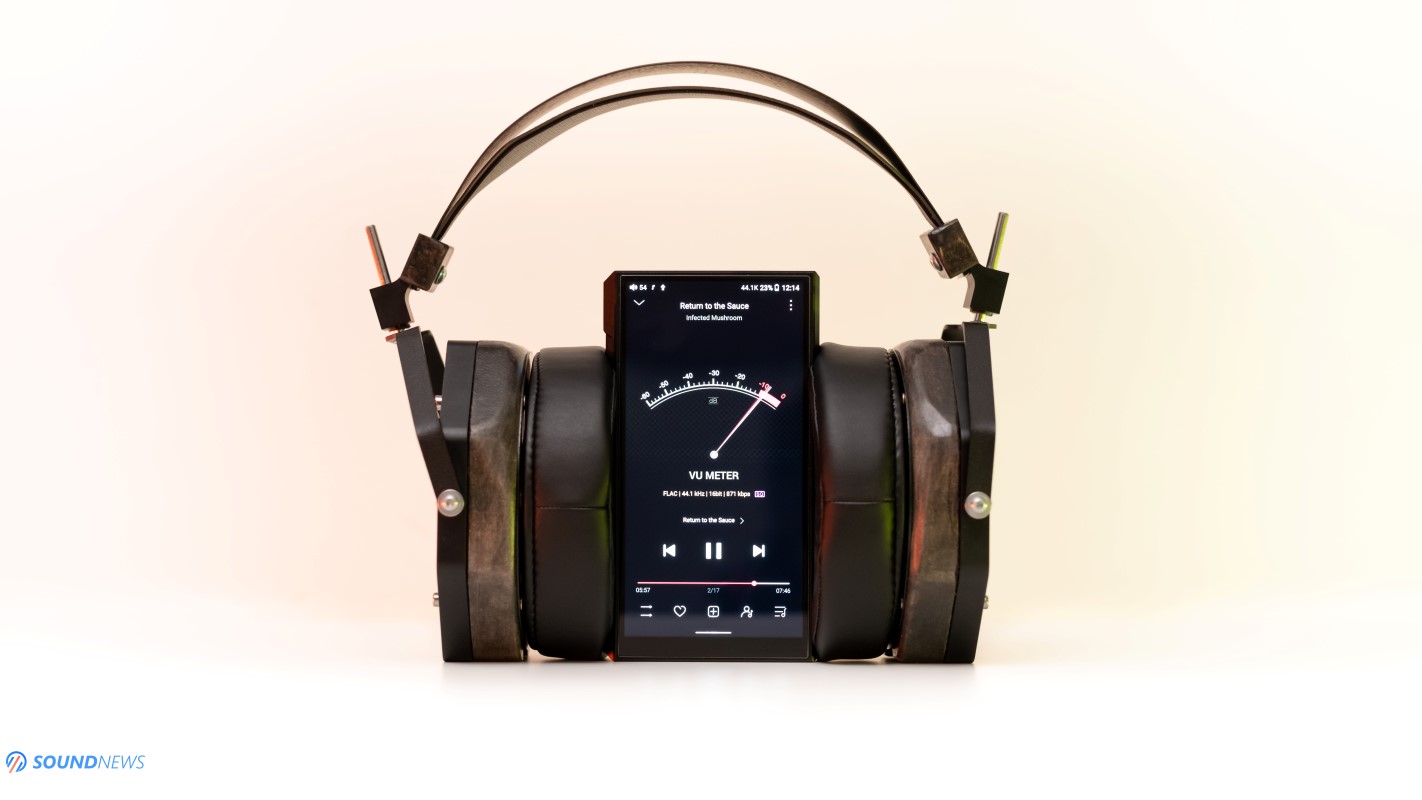
IX. Measurements
After offering my subjective opinion, it is time putting them under a magnifying glass. When it comes to measurements, I have the highest confidence in the Benchmark HPA4, as it is as linear as headphone amplifiers could ever be and I have resumed at using the Matrix Audio Element X as the main DAC for the job. The measurement rig used was the MiniDSP EARS calibrated with HPN (Original Headphone Compensation) files. Do note that MiniDSP EARS is not following any IEC standards, meaning that my readings can’t be used as reference measurements or anything like that, I’m doing them only to get a general idea about their sound signature.
I have measured them for several times, as finding the perfect spot on the test jig wasn’t that easy. No side-pressure was applied on the earcups, they stood still in their natural position and I’ve measured them several times before both channels were matched at less than 0.5 dB.
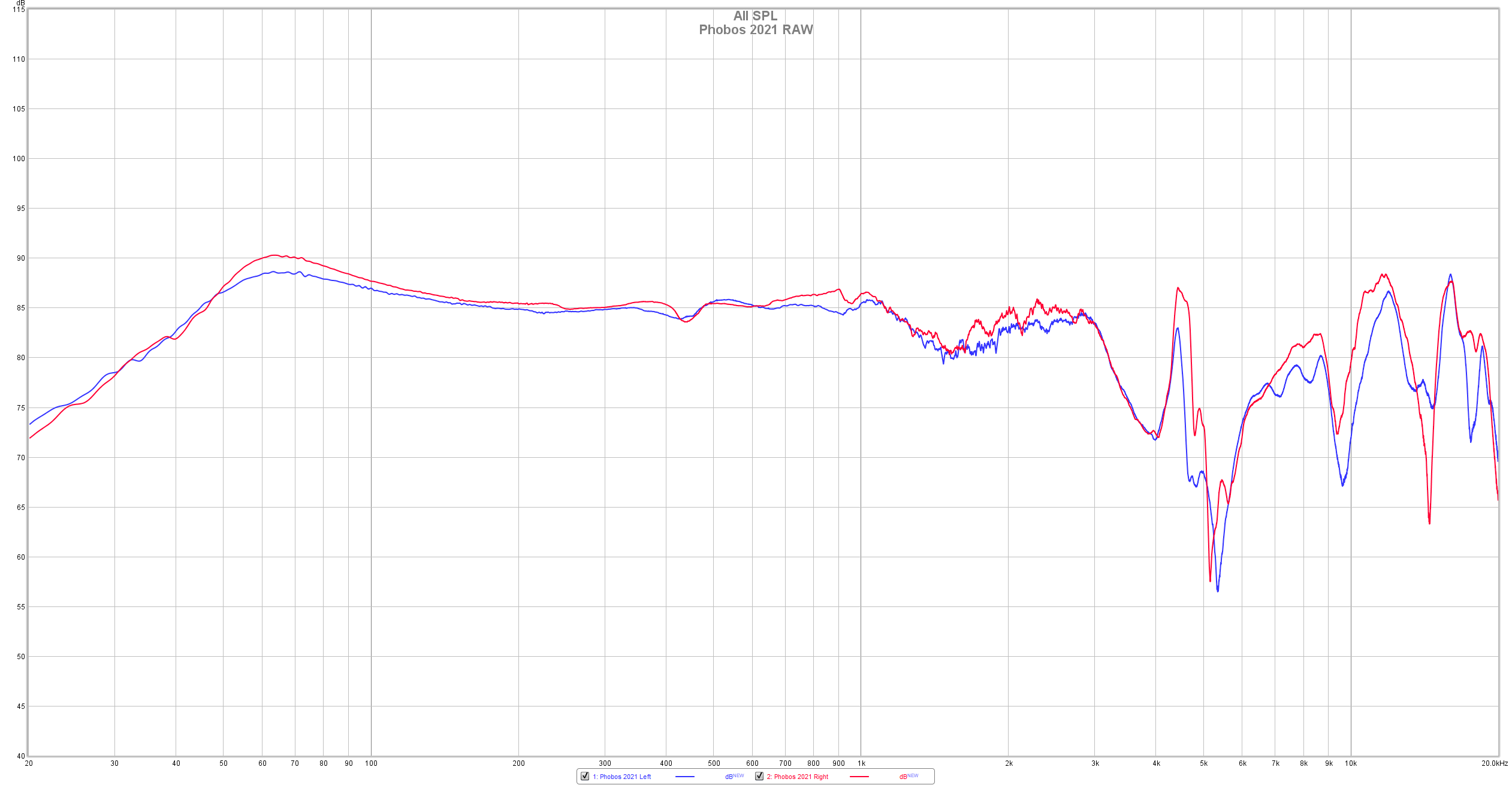
Take a look at their RAW measurements without any smoothing applied. Driver matching isn’t the best I’ve seen, but it isn’t alarming either. Do note that I’ve zoomed this reading quite a lot and all the deviations from the treble region cannot be spotted in real like scenarios.
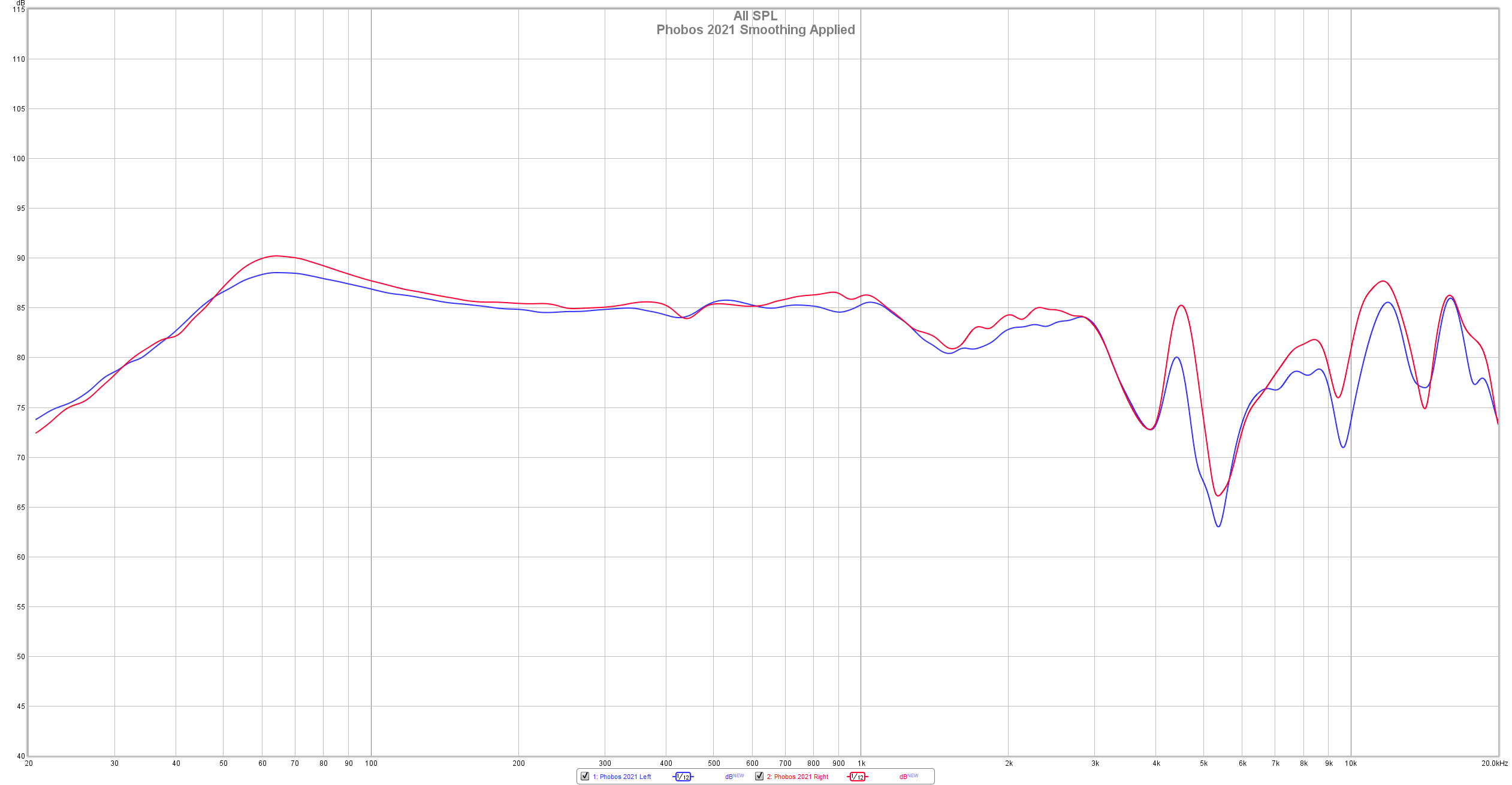
Applying a gentle 1/12 smoothing, I am getting this graph and you can see that Phobos V2021 starts building up bass information up until 50 Hz is being reached. I’ve sent an 84 dB test tone, so everything above or below that number is a deviation from linearity. Mid-bass starts strong, it’s elevated by up to 5 dB and that adds some fun and a higher engagement factor into the mix. Midrange looks good, dropping just 3 dB in the upper region. There are several slopes in the treble, but a can’t spot nasty rises that could make them bright and unbalanced. As I’ve mentioned before, there is a drop at 4 and then at 6 kHz, that scares away brightness and listening fatigue for good. The rest of the treble looks pretty good and there is plenty of presence even past top octave.
As you can clearly see, Phobos V2021 was tuned for long listening sessions, highlighting bass and midrange regions, while dropping down small portions of the treble. Phobos was made to sound natural and fun without causing long term discomfort.
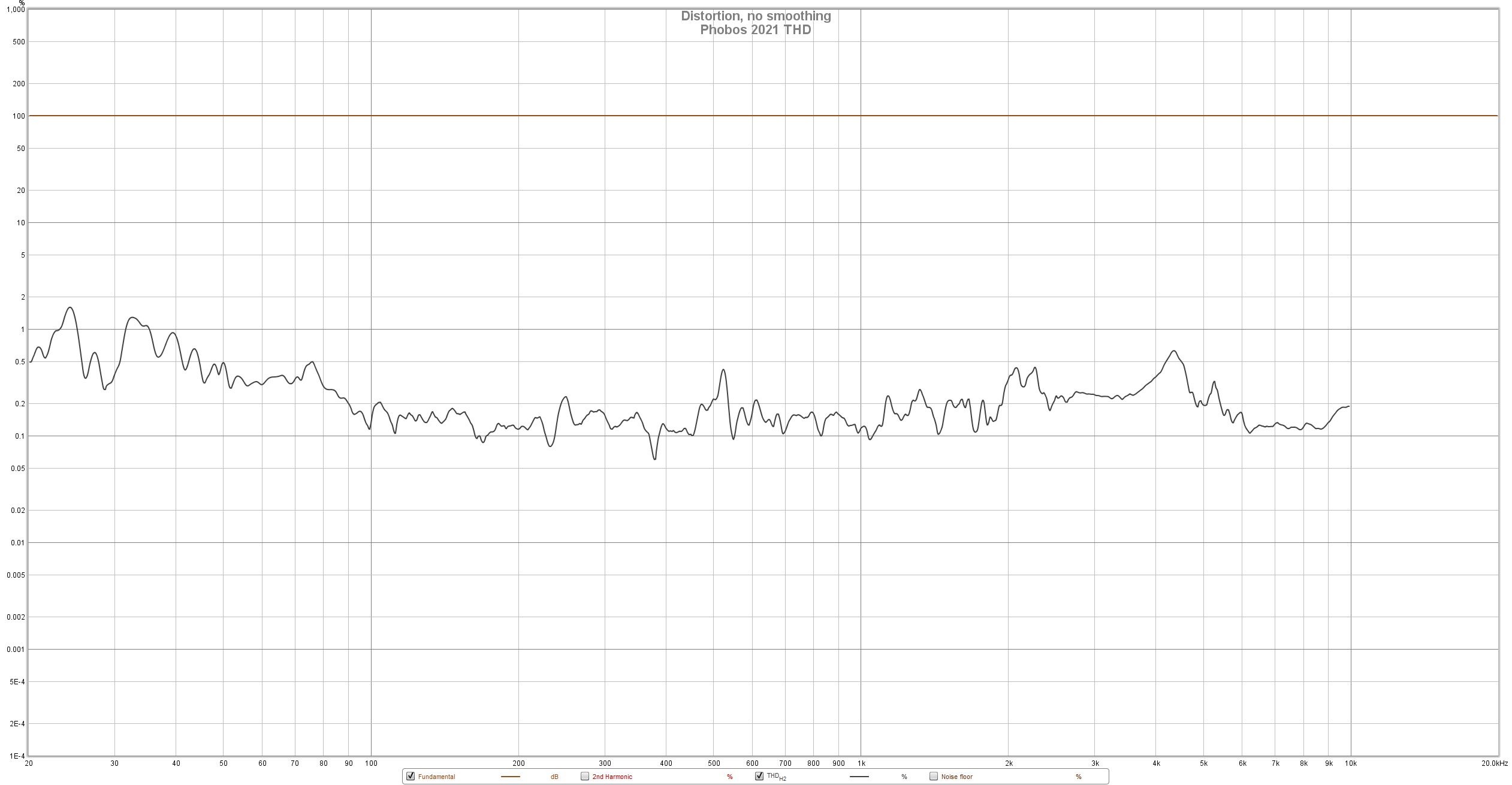
Their THD reading is excellent, it looks a little better to their predecessor that reached 2% in the bass. The newest model reaches 1.5% in there and drops to in between 0.1 and 0.2%, which is truly impressive. Normally, it stays a little higher with open-back planars and much higher with dynamic headphones.
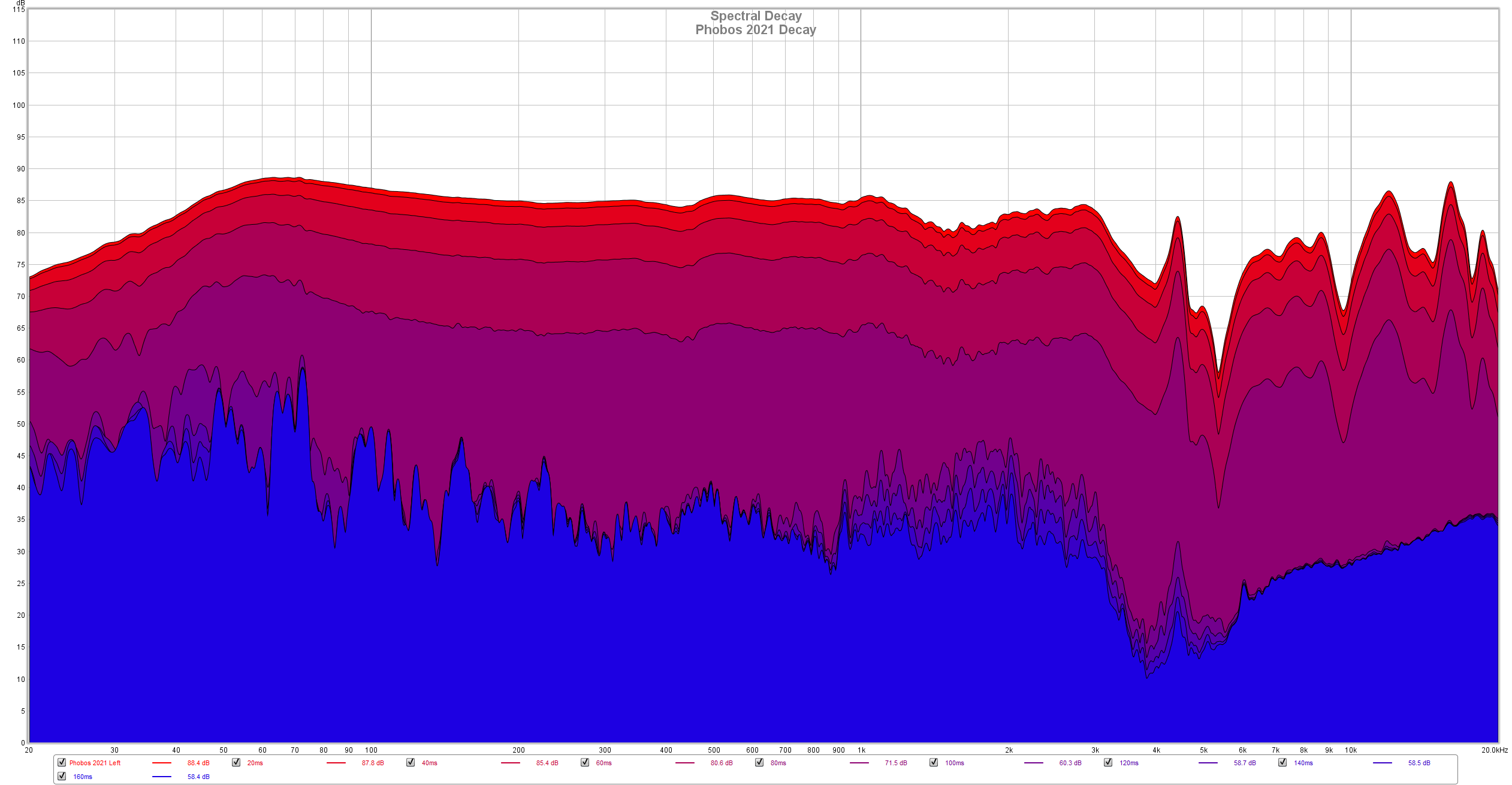
Spectral decay looks good, after sending a 300 Hz sweep tone at 84 dB and after a short time frame of 160ms it drops to 10.5 dB at the lowest point and to 58 dB at the highest point in the FR, strengthening my claims that this is a fast-moving diaphragm.
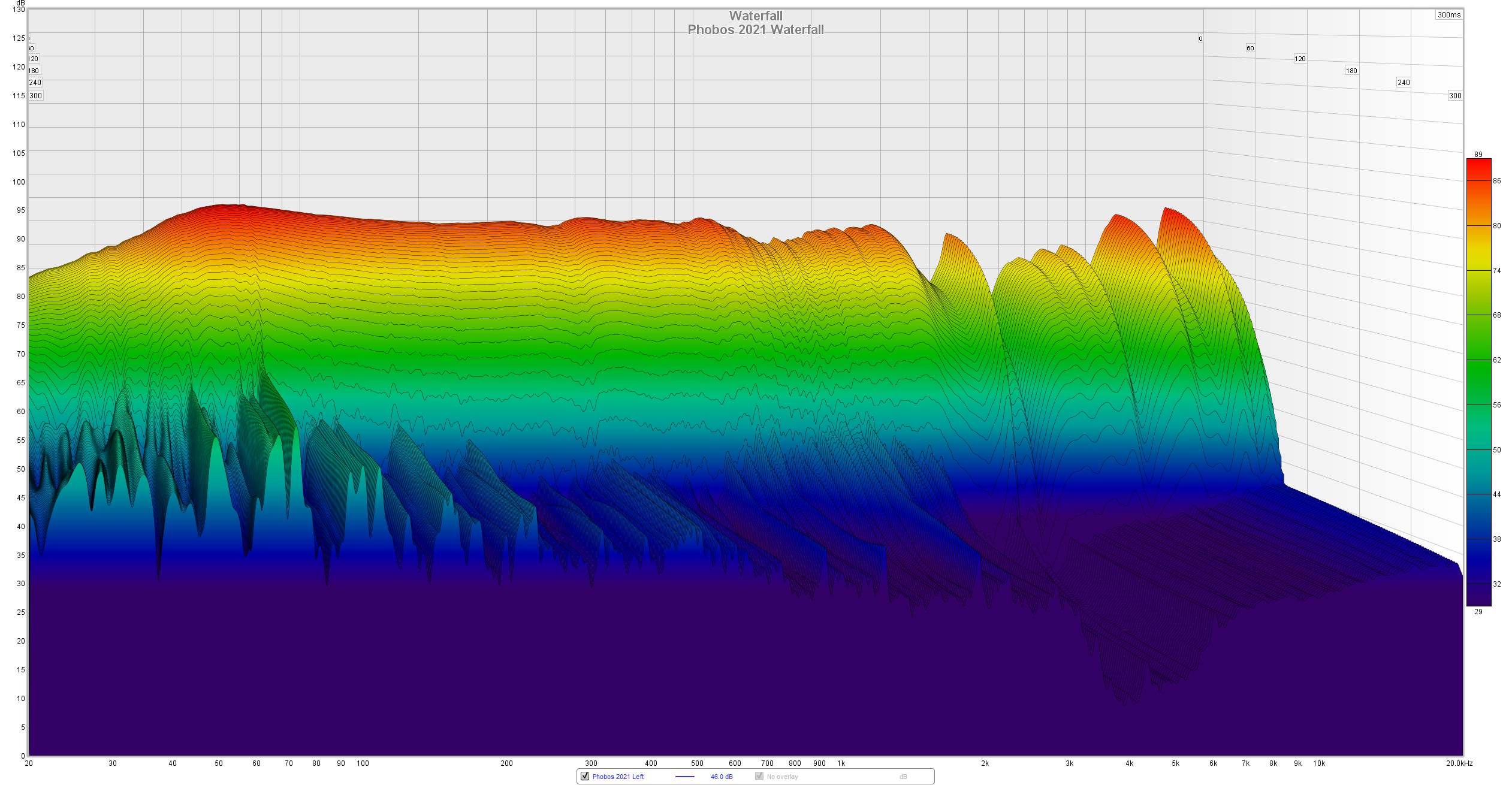
Waterfall combines the FR plot and decay into a single graph and you can clearly see the hot spots in the FR and the slower driver movement in the bass, but that’s normal behavior.
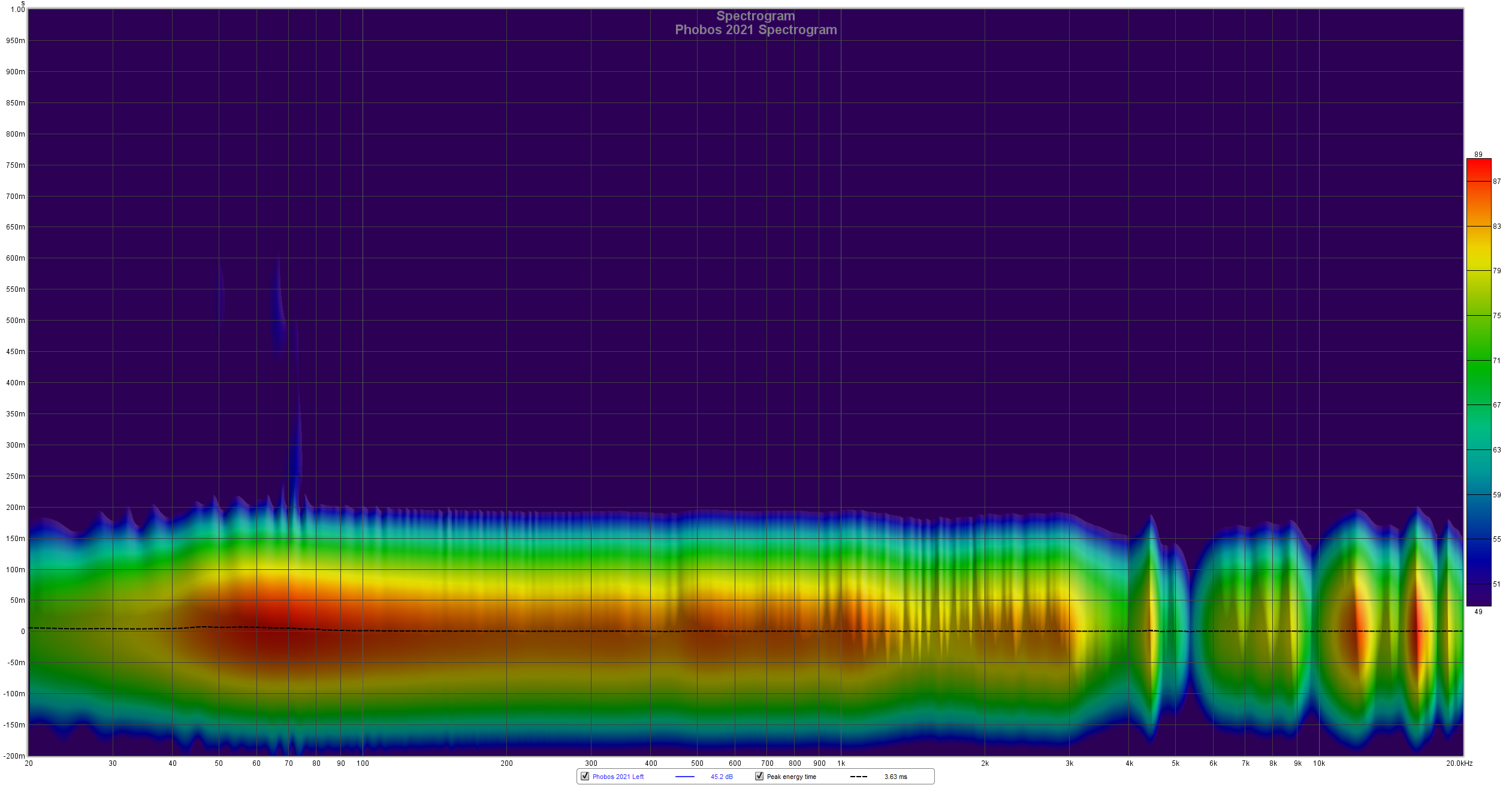
Spectrogram shows zero ringing of the diaphragm and earcups, which makes me very happy and again strengthens my claims that there aren’t nasty vibrations with the newest Phobos.
Overall, I have recorded an impressively low THD, a fast start and stop of the drivers, zero ringing of the cups and drivers and a less impressive driver matching. These are slightly uneven in the FR, but that’s what makes them stand out in the first place. These are some impressive measurements by my standards.
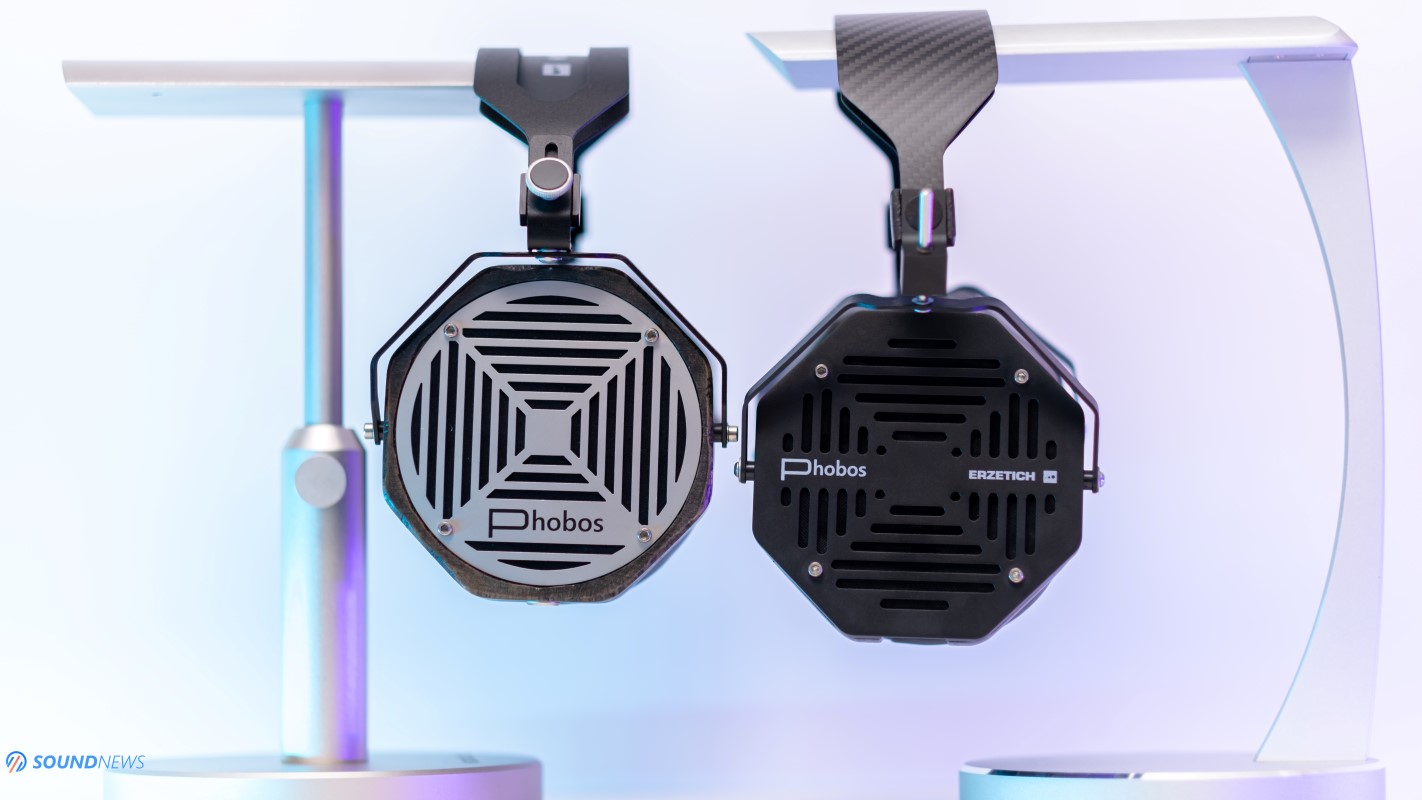
X. Comparisons
A. Erzetich Phobos V2021 (€1999) VS Erzetich Phobos 2018 (€1999)
Build quality wise, there are some important quality-of-life changes brought to the table with the newest model that are needed to be mentioned. 1) You can’t swivel the old Phobos that much, around 10 degrees to either side, making them less comfortable on bigger heads. That also means you can’t lay them flat on the table. With the newest Phobos you can swivel them as much as you want and you can lay them flat if you please. 2) Old Phobos have a defined distance between both cups and you can barely increase or decrease that space. If you have a smaller head, their cups would simply float in the air. For example, my kid cannot comfortable use the old Phobos. The newest model completely solves that issue and you can use them comfortably with bigger and smaller heads. Apart from that, I dig the newest steam-punk look and they appear more refined and finished to me.
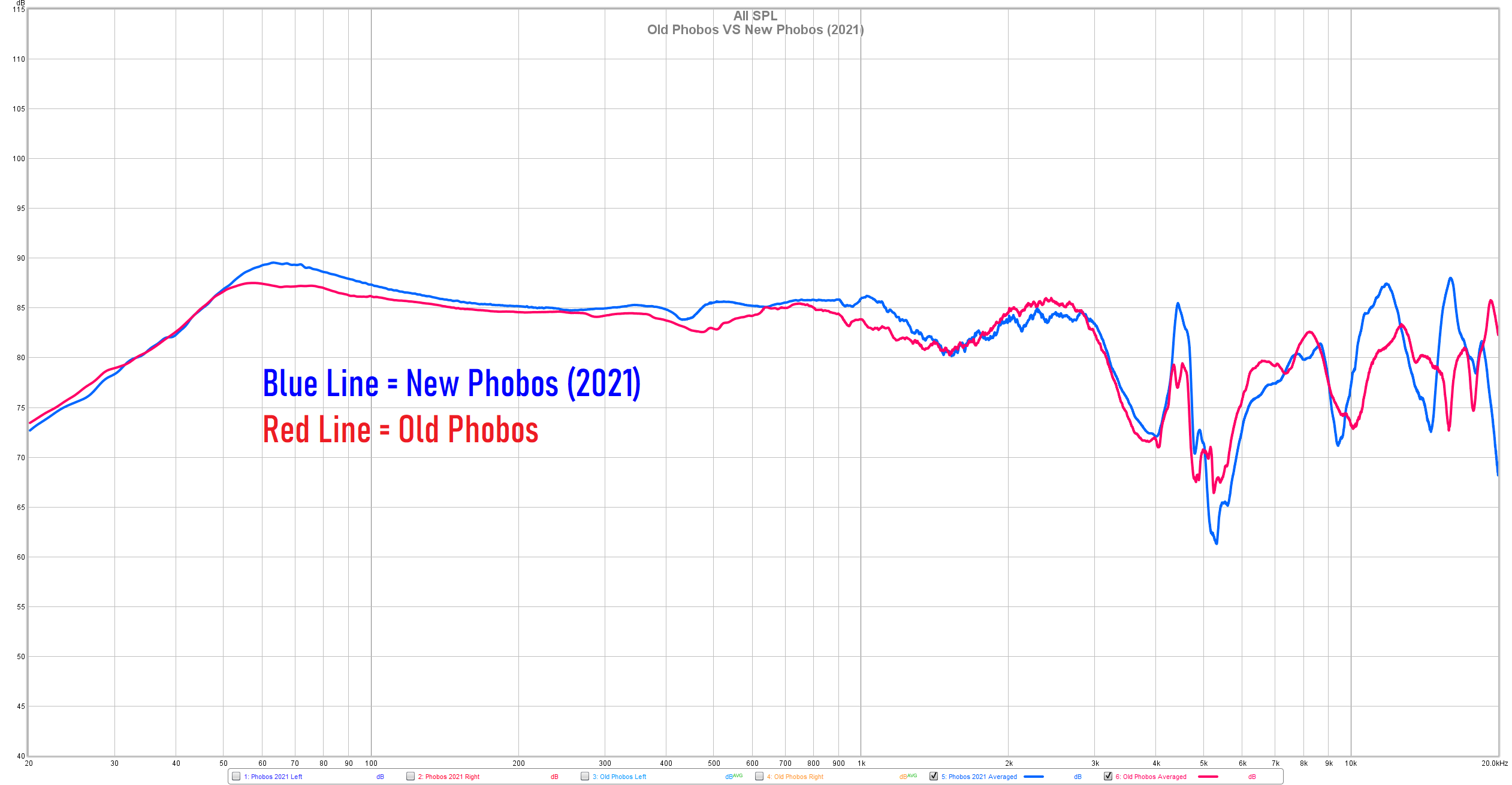
That being said, let’s focus on the sound quality and here’s a FR comparison between them that will tell you something. However, take into account that a graph like this tells you nothing when it comes to detail retrieval and many other things. While they have the same drivers, the same magnets that are put in a similar configuration, Erzetich better decoupled their drivers from its metallic structure, as the newest models doesn’t rattle at higher volumes, improving their transparency and detail retrieval. I can now look deeper into my tracks and everything will sound more focused on the newest Phobos. From this graph, it might look like the old Phobos isn’t bothersome in the treble and should sound just fine and a little smoother, but in reality, it’s the other way around. Old Phobos resonates longer in the treble, adding unwanted distortions in that region, making treble intensive music blurrier and unfocused. It messes with the timing and with the cleanness, something that the newest Phobos never does. The final result is a much clearer, more focused and defined treble, that is even more detailed, while completely discarding brightness and listening fatigue.
When things are getting crowded on Big Things Going Down by Dan Patlansky (Qobuz / Tidal) at the 7 minute and 20 second mark, I could easier trail any note start to finish and focus on anything in particular with the newest Phobos, like I’m looking at a higher resolution picture. The older model messed a few sounds, puts them on top of each other, losing some control and leading edge. The difference becomes bigger with crowded music and less obvious with slower and less complex music.
Apart from that, everything was clearer, more defined and focused, their technicalities plunged higher and I could compare them now with higher tiered headphones any time of the day. Detail retrieval seems better, as if a veil from the older model was lifted. The newest Phobos is a better tool when I’m evaluating new DACs and headphone amplifiers. Their frequency response is more or less the same, but their technicalities are on a different level altogether. This really shows how small differences in timing and driver control could affect the final outcome in a huge way.
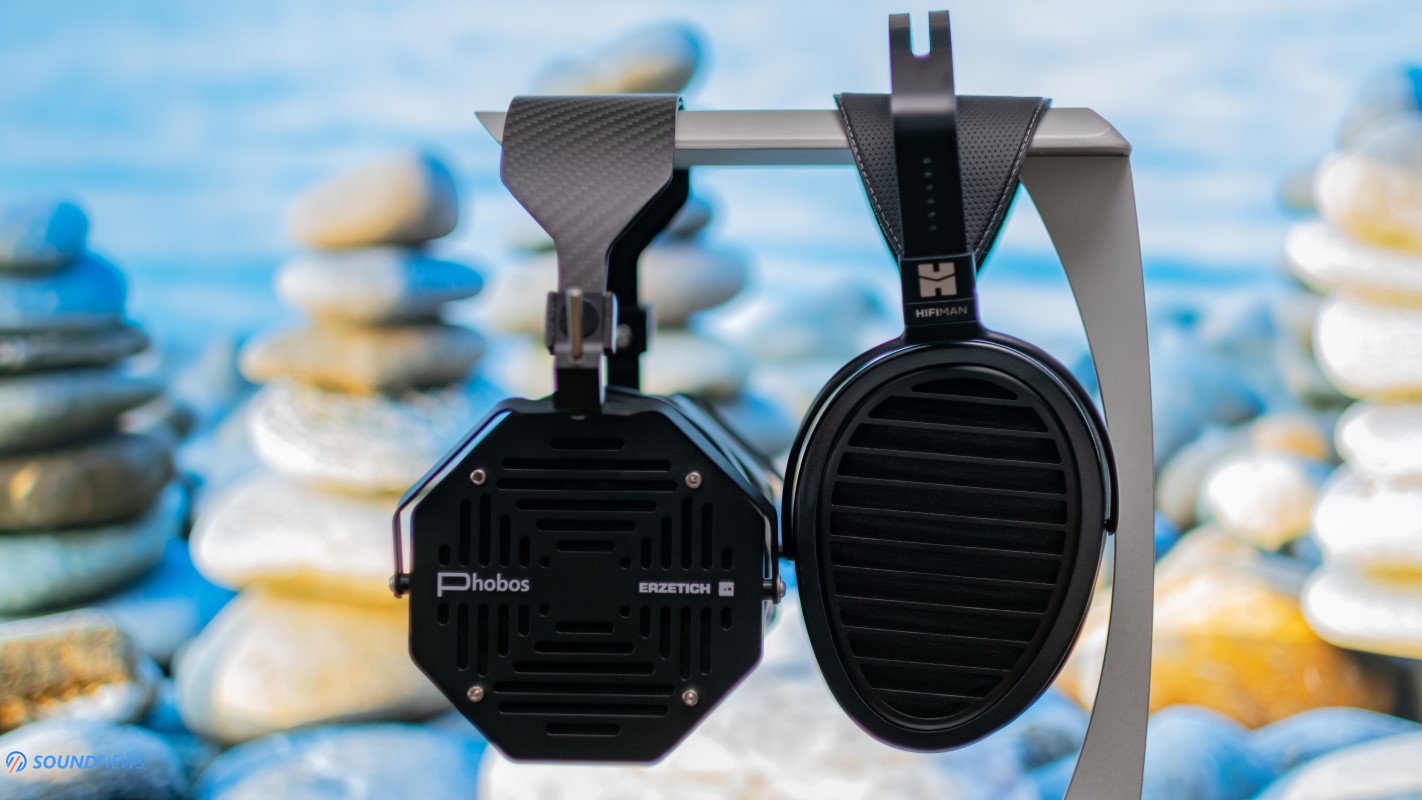
B. Erzetich Phobos V2021 (€1999 EUR) VS Hifiman Arya Stealth Edition ($1599)
Build quality wise, Arya uses a less complicated build, there are several plastic parts which leads to a much lighter frame; that is more comfortable long term, but falls short when it comes to build quality and first impression. Their earcups are made out of plastic, the headphone structure is well put together, but they aren’t screaming a sturdy construction to me. I like their look and their comfort level seems to be very high, as I can wear them for hours without feeling pain on top of my head or around my ears. You should be much gentler with Arya, as their plastic parts might scratch in time and their TPU head-band might degrade as well.
Arya Stealth is less sensitive, it’s much harder to drive, I need to go by ~11 dB higher on the HPA4 to achieve the same SPL. You can almost forget about using the Arya with portable devices, as small dongles won’t work with them, only oversized portable players that have some power to spare. Arya seems to have an elongated driver, but its driver size is actually smaller to that of the Phobos.
When it comes to sound quality, the very first thing that hit me is how close and intimate Arya sounded compared to a decompressed and well-spread nature of Phobos. Everything seems closer to me, but much taller somehow. There are plenty of sounds below my chin and above my head, but their left to right soundstage is less impressive to that of the Phobos. With Arya it’s like looking at a vertical smartphone screen versus an ultra-wide monitor on the Phobos. Stage size is definitely more natural and impressive on the Phobos, as I can listen even to crowed and bad-mastered music, which isn’t that impressive on the Arya.
Second thing that struck me was the impact that both headphones provide. Arya felt like a nimble and agile fighter, landing gentler punches into my eardrums, while Phobos moved by a hair slower but delivered harder punches when bass notes were hitting my eardrums. All things combined made the Phobos more enjoyable in long listening sessions, especially with bass intensive music. If you are into pop, hip-hop, rock, electronica or metal, Phobos became toe-tapping and believe they will deliver a fuller & a more enjoyable experience.
When it comes to frequency response, Arya were impressive and sometimes too correct and robotic sounding. I found them less impressive in the midrange, as they sounded by a hair thinner and they went much higher in the treble. The aforementioned track by Dan Patlansky is heavy on the treble towards the end to a point of becomes slightly harsh and bright on the Arya. Cymbals crashes and hi-hats had a very defined metallic nature that posed a problem in long listening sessions. If you consider yourself a treble head, Arya might sound nicer to you, but for my taste, Phobos V2021 seems more even and more balanced in the frequency response. With Arya Stealth, system matching becomes a very important aspect, as they aren’t working that great out of ESS-Sabre and THX-AAA based amplifiers. My particular combo (Matrix Element X and Benchmark HPA4) made them lifeless and quite thin sounding, but when I’ve swapped the HPA4 with a Flux Lab Acoustics Volot, things improved considerably and I could enjoy the Arya much easier now. System matching is a non-issue with Phobos, but it becomes an important task with the Arya. I could see many of you using the Arya with tube amplifiers or with Class-A transistor-based amplifiers, which isn’t really mandatory with the Phobos.
A higher treble emphasis might let you think that Arya is more detailed and more resolving, but that looks like a mind-trick to me, as I find them equally impressive when it comes to technicalities.
I like them both and I understand them both, I can make them sing with a careful system matching, but to me, Phobos is a headphone that speaks directly with my soul. I can enjoy it even with portable devices and I would never check their electronics laying inside. It just works with everything I throw at it, it’s easier to enjoy in long listening sessions and it seems to be built at higher standards. It really depends on what kind of listener you are, but I prefer the Phobos to due its fuller bass and midrange performance, that is adding some weight and substance, ultimately awakening more emotions from my music.

My Conclusion
In the end, Erzetich Audio took an already excellent sounding headphone and hammered down all the imperfections that I had with them in the past. Their metallic cups should resist a lot more use and abuse and their carbon fiber headband add some high-end flair to them. More importantly, several quality-of-life changes were brought to the surface and you can now use them with smaller or bigger heads and you can lie them flat on your table if you please.
Apart from this, this is the same good-old Phobos that sounds big and enveloping, while toning down brightness and listening fatigue. Transparency and detail retrieval went up and nasty distortions and driver rattles went down, improving their timing and control, especially at higher volumes. In my case, Phobos V2021 checked many boxes and I’ve used them in most of my DAC and headphone amplifier reviews that I’ve posted in the latest months. I find them easy to drive and easy to like, as system matching isn’t an issue anymore, as it can be the case with several high-end headphones.
Considering all the improvements made to their build and driver assembly, I cannot continue without awarding them with our highest badge. Gold Award is fully deserved and I challenge you to find a more interesting-sounding headphone in the ~€2000 price bracket.

Being a high-end headphone, not a lot of people can afford them…but maybe I can change that, as I’ve cooked a pleasant surprise for you. I’ve partnered with the Erzetich team and prepared a 15% discount for all things Erzetich Audio, not only for Phobos V2021. At check-out, please use a “SOUNDNEWS” discount code for a 15% OFF, that’s €300 less for the Phobos alone. Please hurry up as this code expires on the last day of 2021! In case you get them, please leave a comment below and let me know how they are treating you.
PROS:
- A strong a sturdy headphone, I like their steam-punk look and as an added bonus they will scare children on Halloween.
- Easy to service, every part seems to be replaceable
- Quite comfortable in long sessions, my ears aren’t touching the driver assembly
- Very easy to drive, even small dongles and portable DAC/Amps will work no problem
- System matching is a non-issue, as they work well with pretty much everything
- Vast, expansive, open and wide soundstage
- Easier to focus on anything particular, imaging felt improved and also their depth
- Technical-sounding headphones, they will impress headphone geeks
- Detail retrieval is impressive, up there with some of the best headphones
- Accelerates instantly and can keep up with demanding tracks, speedy sounding headphone
- Easy to like due to a natural rendition of bass and midrange
- Lacks brightness and listening fatigue
- Brings huge improvements to its predecessor, while costing exactly as much
- All things considered, their price is fully justified
CONS:
- Rigid stock cable has some microphonics
- Would like to have a usable hard case, instead of a boring velour pouch
- Not a perfect driver matching
- Lacks some definition in the sub-bass
ASSOCIATED EQUIPMENT:
- DACs: Audiobyte HydraVox & HydraZap, Musician Aquarius, Matrix Audio Element X, Gold Note DS-10 Plus & PSU-10 EVO, SMSL D1 SE, Topping D90 SE, Singxer SDA-6 Advanced
- DAPs: FiiO M11 Plus LTD, M15, Shanling M8, M6 V.21
- Headphone Amps: Flux Lab Acoustics Volot, Benchmark HPA4, Burson Soloist 3X, Musician Andromeda, SMSL SP400, Gustard H16
- Preamps: Musician Monoceros, Benchmark HPA4, Topping PRE90
- Power Amplifiers: Benchmark AHB2 (x2), KECES S300, SMSL SA400, Burson Timekeeper 3i
- Integrated Amplifiers: KECES E40, Burson Timekeeper 3i
- Loudspeakers: KEF Reference 3, Sound of Eden Crescendo UNO, Natural Sound NS17
- IEMs: FiiO FA9, FH7, FH5S, FD7, Meze Rai Penta, Rai Solo, LittleDot Cu KIS, Hiby Crystal 6, IKKO OH10, Moondrop KATO, 7Hz Timeless & others
- Portable headphones: Sennheiser Momentum 2, Meze 99 Classics, Sony WH1000-XM4
- Full-sized headphones: Hifiman Susvara, HE1000SE, Arya, HE400SE, Audeze LCD-4, Erzetich Phobos 2021, Phobos V2018, Erzetich Mania, Kennerton Wodan, Magni, Gjallarhorn, Vali, M12S, Ollo S4X Reference, Apos Caspian, Sendy Peacock & Aiva
- Interconnects: QED Reference (x2), Topping TCX1 (x2)
- Speaker cables: Kimber PR8, Audioquest Type4
- Power Cables: Isotek EVO3 Premier (x3)
- Balanced Isolation Power Conditioners: PLiXiR Elite BAC1500 (stereo setup), Elite BAC400 (headphone setup)
